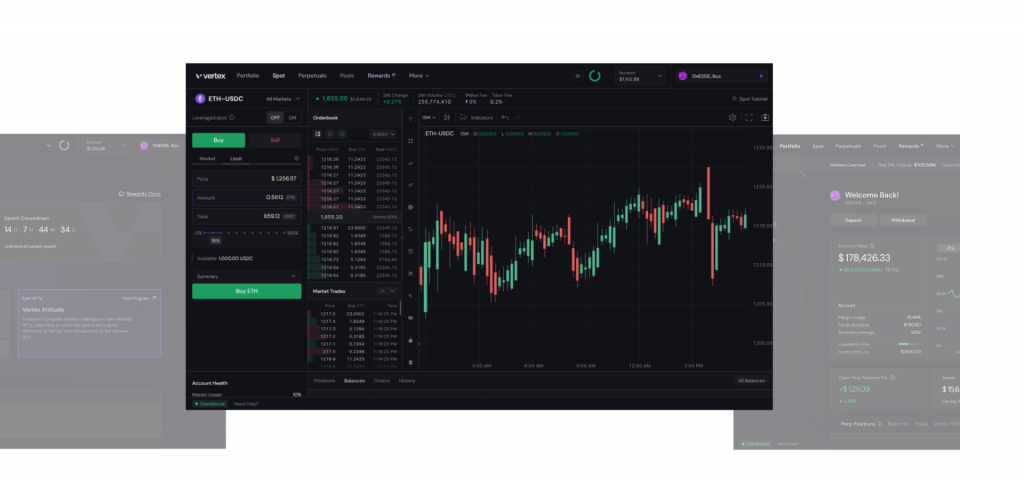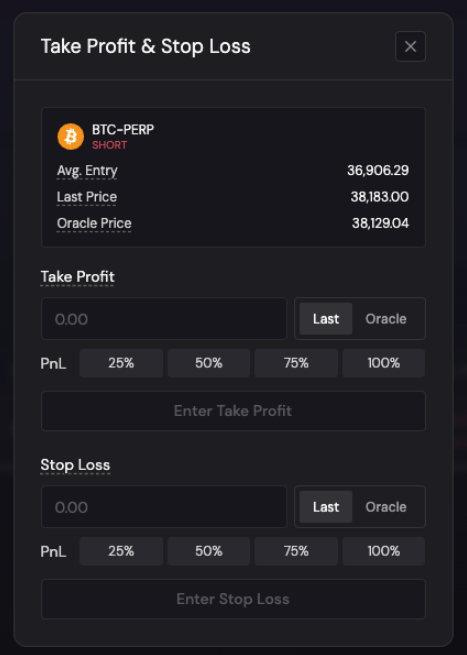Overview
Vertex is a decentralized exchange (DEX) on Arbitrum, offering a versatile platform for spot and perpetual trading with margin capabilities. The defining characteristic of Vertex is its vertically integrated approach, encompassing various trading features within a single application. This includes spot and perpetual contracts as well as an integrated money market.

At its core, Vertex provides a Universal Margin Account, enabling users to manage risk effectively by utilizing their entire portfolio as margin. Trading accounts on Vertex are universally cross-margined by default. The platform’s universal cross-margining simplifies trading by combining multiple open positions into a single trading account. This approach optimizes capital efficiency, reduces initial margin requirements, and enhances risk management. Furthermore, Vertex’s integrated money market lets users earn yields automatically on deposits and borrow assets against their margin, supporting various collateral types.
Vertex’s trading system combines a Unified Central Limit Order Book (CLOB) through an off-chain sequencer, and an on-chain Automated Market Maker (AMM). This integration provides users with a user experience akin to centralized exchanges (CEX) while preserving the self-custody advantages associated with decentralized exchanges (DEX). Liquidity from pairwise LP markets enhances the order book, while the specific implementation on Arbitrum helps to reduce Maximum Extractable Value (MEV) and reduces gas fees.
Vertex’s AMM operates on-chain within the protocol layer, constituting the default state known as “Slo-Mo Mode.” Complementing the on-chain AMM is Vertex’s off-chain order book, referred to as the “sequencer.” This approach aims to combine the best of both worlds – the speed and capital efficiency of an orderbook, and the passive liquidity of the AMM.
The sequencer operates as an off-chain node layered atop smart contracts within the Arbitrum protocol, delivering order matching at competitive speeds. Nonetheless, Vertex prioritizes user control, ensuring that assets remain under the user’s control on-chain. It also boasts incredibly low-latency trading, with order execution speeds of 10 – 30 milliseconds, competitive with leading CEXs.
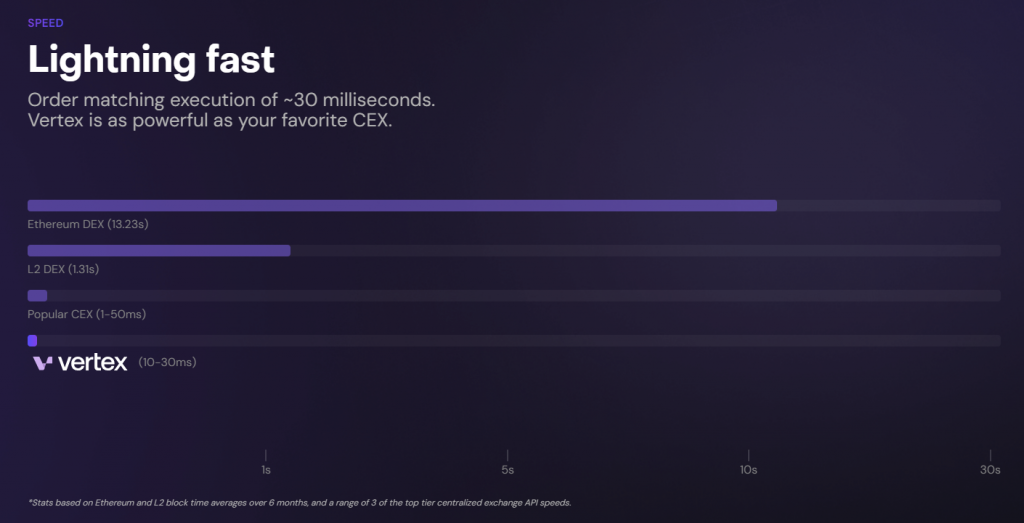
With this hybrid design, Vertex pools liquidity from its on-chain AMM and the sequencer, augmenting liquidity through smart contracts rather than relying solely on external APIs. This consolidation creates a unified source of liquidity, fostering an efficient trading environment where users can seamlessly execute orders.
Spot Markets
Spot markets enable the exchange of assets with immediate settlement upon trade execution. When you buy or sell a crypto asset on Vertex’s spot market, you receive or deliver the asset instantly. As everything in crypto, Vertex’s spot markets operate around the clock, 24/7, providing you the flexibility to trade crypto assets at any time of day or night. This accessibility caters to traders in different time zones and allows for uninterrupted trading opportunities.
Crucially, Vertex maintains the DeFi principle of self-custody in its spot markets. This means that you always retain full control over your spot assets on-chain. Your assets are never held in a centralized custodial account, ensuring you have complete ownership and transparency.
Vertex’s spot markets pair a selection of assets with USD-denominated stablecoins, simplifying trading and quoting all spot assets in $USDC. It is also worth noting that more assets will be added over time.
Perpetual Markets
Perpetual futures contracts allow traders to speculate on price movements without the need to take ownership of the underlying assets. They are primarily used for speculation and hedging, and they are one of the most popular derivatives instruments in crypto.


When trading perpetual futures, the price of the contract is tethered to the underlying asset via funding rates, which modulate the incentive to go long or short by assigning a positive or negative carry cost to a specific perpetual position.
- When the price of the perpetual contract is higher than the spot price, traders with long positions must pay a funding fee to traders with short positions.
- When the price of the perpetual contract is lower than the spot price, traders with short positions must pay a funding fee to traders with long positions.
This funding fee helps to bring the price of the perpetual contract back in line with the spot price by incentivizing traders to open positions on the underweight side.

It is also worth noting that Vertex’s cross-margin system leverages spot assets held in the Money Market to back perpetual positions, offering a seamless and efficient margining process.
Similar to spot markets, more assets will be added over time.
Money Market
Decentralized money markets allow users to borrow and lend crypto assets without the need for intermediaries. Vertex takes this a step further by integrating a money market directly into a DEX.

Interest Rates
Similar to other decentralized money markets, interest rates are a dynamic function of supply and demand. Depositors act as liquidity providers (LPs) to the pool and earn a proportional share of the prevailing interest rates paid by borrowers. This mechanism enables passive yield on idle assets for users.
Vertex uses a dynamic interest rate model that adjusts in real time based on the demand within collateral pools. If more borrowers enter the market, increasing loan demand, the interest rates will rise to incentivize lending. Conversely, if there are more lenders than borrowers, interest rates will decrease to encourage borrowing.
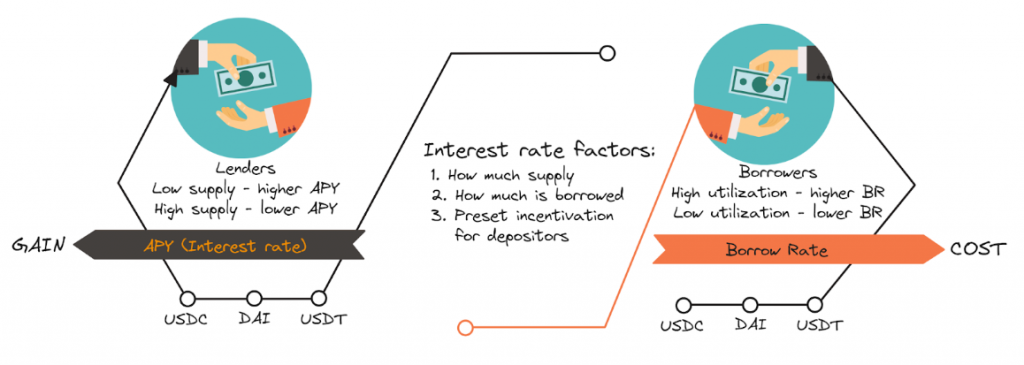
Vertex’s money market introduces spot rates for each spot product, defined by attributes such as small_cap, large_cap, floor, and inflection. Borrow rates and deposit rates are calculated based on these parameters and the utilization ratio, with adjustments made approximately every 15 minutes.
- small_cap is the peak interest rate in the first part of the utilization curve.
- large_cap is the peak interest rate at 100% utilization.
- floor (R0) is the minimal rate for borrowing.
- inflection (kink) (Uoptimal) is the utilization rate where the slope of the interest rate curve steepens.
- interest_fee is the protocol fee taken from borrow/lending markets
Utilization Ratio Formula:
Borrow Rate:
Deposit Rate:
To ensure the integrity of the lending process, Vertex’s smart contracts are programmed to execute predefined rules and conditions automatically. If a borrower fails to maintain the required collateral level, keepers step in to liquidate the collateral and use it to repay the lender. This automated loan management is integrated into the cross-margin function associated with each subaccount, simplifying and streamlining the loan management process.
As with spot and perpetual markets, the list of available assets is expected to grow over time.
Hybrid Orderbook AMM
Vertex’s exchange model aims to combine the best of both worlds by merging a fully on-chain trading venue and risk engine at the protocol level with an off-chain sequencer. This hybrid approach forms the backbone of Vertex’s decentralized exchange (DEX).
The on-chain trading and risk engine contains Vertex’s core products, including spot, perps, and money market – operated by smart contracts deployed on Arbitrum.
The sequencer lives off-chain and enables a high-performance orderbook that matches inbound orders fed from the protocol layer with extremely low latency.
Vertex’s on-chain clearing house operates as the hub combining perps and spot markets, collateral, and performs risk calculations within a single integrated system.


The combination of an on-chain AMM and an off-chain orderbook forms a unique trading stack with benefits such as:
- High performance, achieving impressive speed comparable to CEXs, with average order-matching execution speeds between 10 and 30 milliseconds.
- Flexible liquidity deposits. By combining an AMM and orderbook, Vertex maximizes liquidity advantages. Users can trade directly on-chain using the AMM, benefiting from passive liquidity provision and access to long-tail DeFi assets.
- Diverse product suite by incorporating DeFi primitives including spot and perpetuals trading, and an integrated money market, catering to different trading strategies and preferences within a single platform.

Besides the advantages mentioned above, this hybrid model is key to enable a more efficient trading experience that resembles CEXs.
- Trades always execute at the best available price, as the sequencer sources liquidity from limit orders and LP positions concurrently.
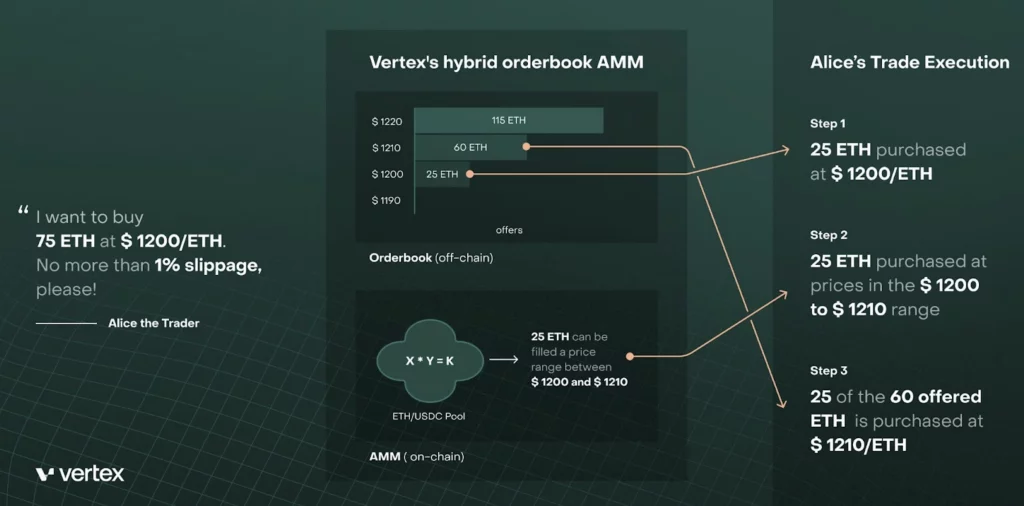
- Some liquidity will always be available to clear trades. Markets can be seeded with more passive liquidity while still allowing for more flexibility through limit orders – benefitting both illiquid and liquid assets.
- Vertex minimizes Miner Extractable Value (MEV) risks, thanks to its fast execution and the use of Arbitrum, which periodically submits batches of transactions to Ethereum L1.
- Users can trade directly on-chain without relying on the sequencer if they choose to do so.
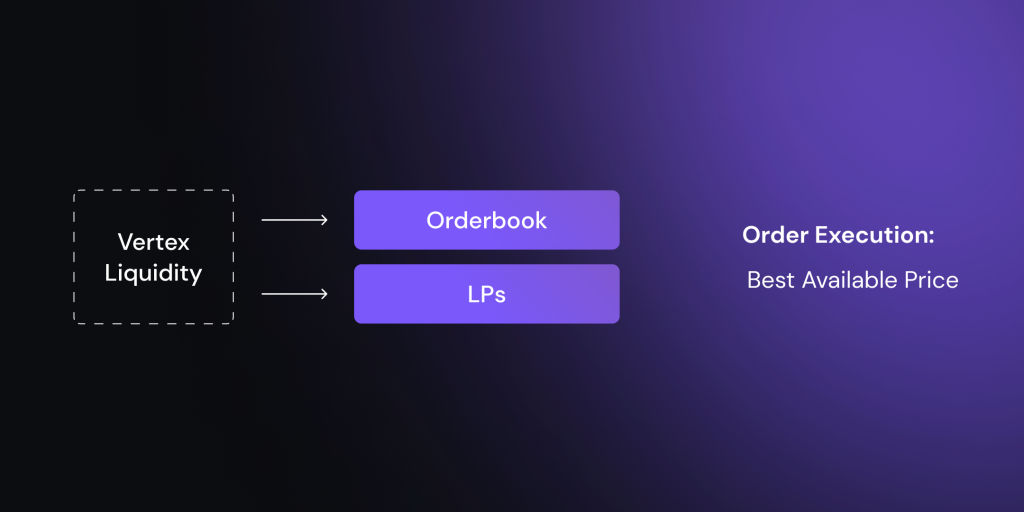
- The existence of the AMM empowers users with two of their core value propositions:
- The ability for users to provide passive liquidity to asset pools and start earning trading fees in a permissionless way.
- Support for long-tail illiquid assets.
Combined with the off-chain orderbook, Vertex can offer a more performant trading engine than standard DEXs. Liquidity is augmented as positions from pairwise LP markets populate the orderbook as well.
Additionally, an HFT-friendly API enables programmatic traders to plug their strategies into the orderbook and trade against the combination of AMM and orderbook and high speed.
Initially run by the Vertex team, the sequencer operates with a TPS of 15K and latency between 10 – 30 ms. It is important to note that the use of Arbitrum prevents any kind of transaction reordering or front-running. Also, the sequencer has no custody over the user’s assets, and it cannot pause trading or halt withdrawals.

As Vertex evolves, the idea is for the sequencer to become decentralized via governance. Meanwhile, in the case of maintenance, downtime or any other unforeseen circumstance, the AMM layer functions as the backstop of the protocol, enabling users to trade solely against the AMM, without needing the orderbook. As a result, instead of getting a CEX-like experience, you would get a UX closer to Uniswap but with cross-margined accounts for spot, perps, and an integrated money market.
Slo-Mo Mode
Slo-Mo Mode represents a foundational aspect of Vertex’s hybrid orderbook-AMM design, offering users an alternative trading mechanism during instances when the off-chain sequencer might be unavailable or when users prefer to engage directly with on-chain mechanisms. This mode is characterized by increased transaction execution times and potentially wider spreads compared to the high-speed, low-latency trading experience facilitated by the off-chain sequencer. However, it upholds the core principles of decentralization and self-custody, emphasizing the autonomy and security of user assets.
In Slo-Mo Mode, Vertex users can still execute swaps, manage perpetual positions, and interact with the platform’s diverse financial products, albeit with the nuances typical of traditional AMM-based DEXs like Uniswap. This includes experiencing slippage, which is the difference between the expected price of a trade and the executed price, and facing wider bid-ask spreads, especially in less liquid markets. Despite these limitations, Slo-Mo Mode ensures that trading on Vertex remains uninterrupted, maintaining user access to the platform’s liquidity pools and trading pairs.
This mode leverages the xy=k algorithm for AMM functionality, enabling users to provide liquidity and trade directly on-chain. It serves as a critical safety net, ensuring that even in the absence of the sequencer, Vertex’s market dynamics remain operational, safeguarding against downtime and maintaining continuous market access. The on-chain risk engine and liquidity pools continue to function, albeit with the inherent on-chain constraints of higher gas costs and slower transaction speeds compared to the sequencer’s capabilities.
Slo-Mo Mode also plays a vital role in preserving the decentralized ethos of Vertex, allowing users to retain full control over their assets without reliance on the sequencer. It exemplifies the platform’s commitment to offering a seamless transition between high-speed trading and the traditional on-chain DEX experience, ensuring that Vertex remains adaptable to various market conditions and user preferences.
Slo-Mo Mode is an essential component of Vertex’s hybrid model, offering a reliable and decentralized trading option that complements the high-performance features of the off-chain sequencer. It ensures that Vertex users can enjoy the benefits of both centralized exchange-like efficiency and decentralized, permissionless trading, embodying the platform’s innovative approach to merging the best of both worlds in the decentralized trading landscape.
Edge
Edge is a Synchronous Orderbook Liquidity layer created to unify liquidity across multiple chains. It is an upgrade to the existing Vertex sequencer, extending its capabilities to support cross-chain functionality. The idea behind this is to forge the path for the sequencer to run on multiple chains simultaneously without fragmenting liquidity between them.
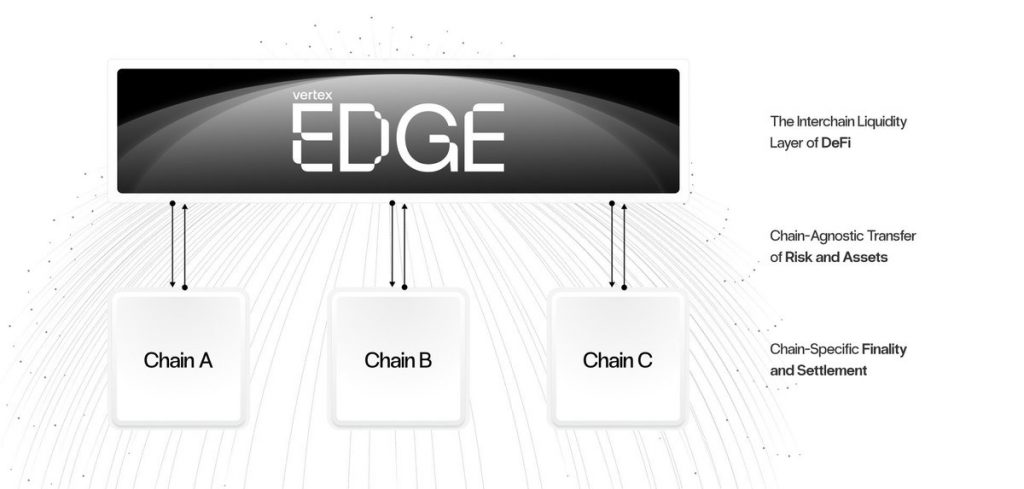
Edge operates as a virtual market maker between DEXs on different chains, matching inbound orders from one chain with the combined orderbook liquidity of all the base layers plugged into the sequencer. This solves for the liquidity fragmentation problem, allowing users to trade against unified cross-chain liquidity on a single DEX without having to move from Chain A to Chain B.
This works by sharding (splitting) the state of the sequencer between support chains in a concurrent manner, intaking and cloning inbound orders from each chain. This way independent orders from one chain can be matched against liquidity from multiple chains. Both sides of a trade would be filled out, and the sequencer (Edge) takes the opposite side of the inbound trade – automatically hedging and rebalancing liquidity on the back end between chains.
This is achieved by having the sequencer only mirror resting liquidity (e.g. maker order) across the sharded states of the Vertex instances on different base layers. Meanwhile, taker orders remain unchanged and are submitted directly from an independent Vertex instance to the sequencer’s unified liquidity layer.
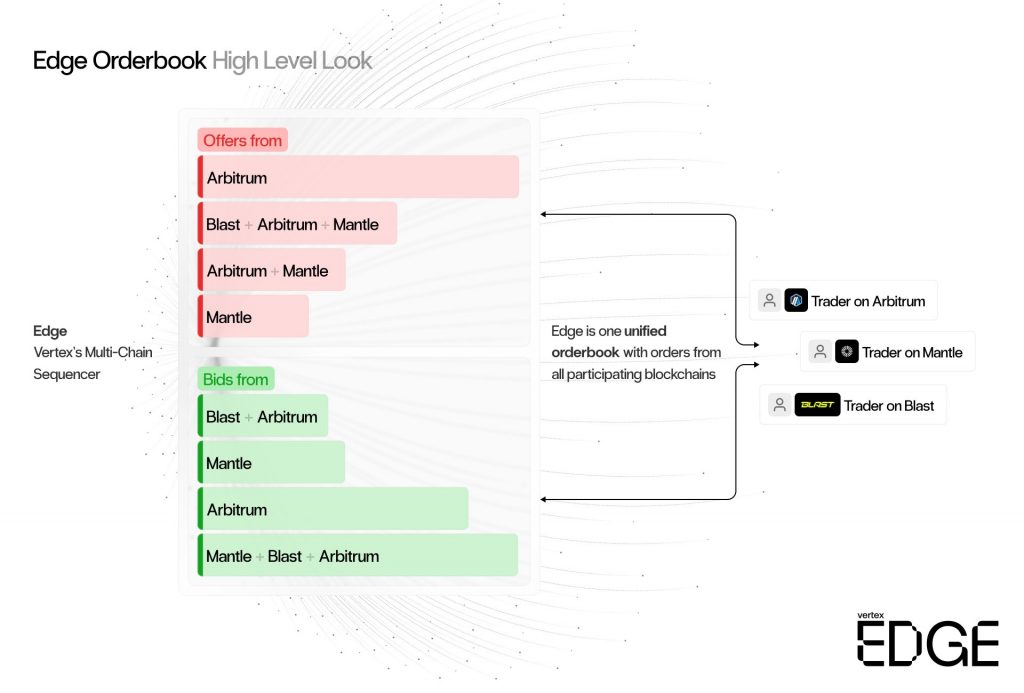
Note that order matching between chains occurs concurrently, and the liquidity profile consolidated on Edge is propagated to each Vertex instance. This makes it possible to match inbound orders from one chain with the combined orderbook liquidity of all the base layers plugged into the sequencer.
The end goal is to unify liquidity and become a foundational building block for other ecosystems. This aggregated liquidity is accessible to all users of any cross-chain Vertex instance (e.g. non-Arbitrum). Settlement of matched orders still occurs locally on-chain on the original source chain of the user, ensuring that there is demand for blockspace and all transactions are made available in a transparent way.
Each inbound order from a Vertex instance can be considered as a request to modify a balance on-chain and, therefore, settlement occurs on those specific chains by updating the corresponding balances.
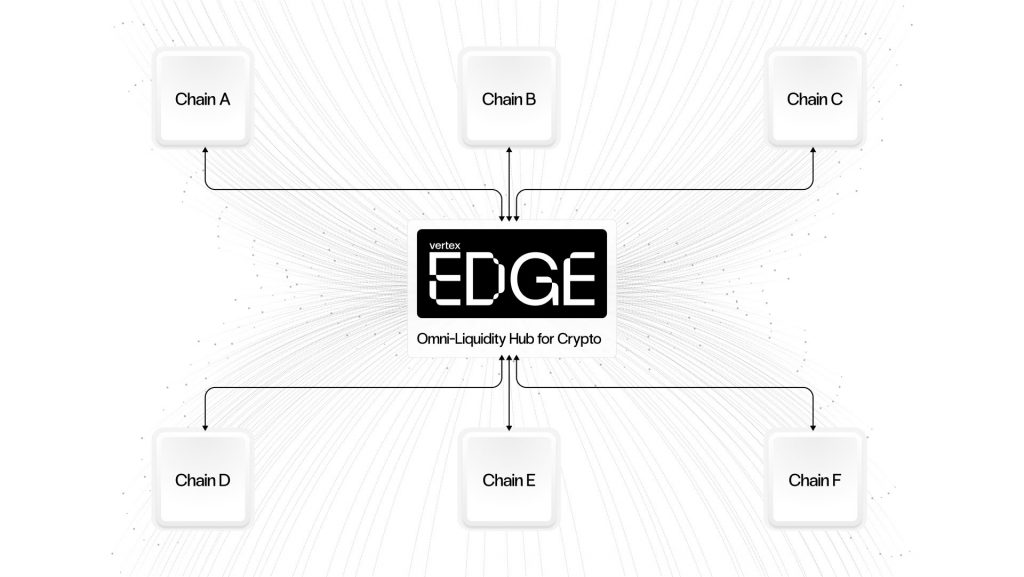
Additionally, Edge unlocks unique features by empowering its core products and tying them together in a unified liquidity environment. At the same time, the aggregated liquidity via Edge is accessible by any user of a cross-chain Vertex instance (e.g., non-Arbitrum), displayed as a single, synchronous orderbook on the corresponding app’s interface.
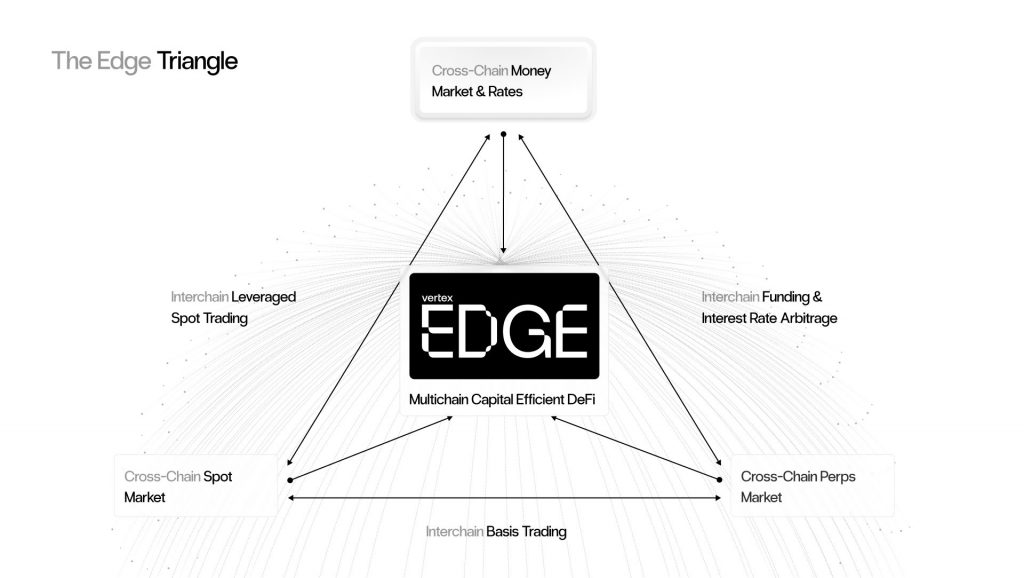
The spot market can perform cross-chain asset swaps of native assets without the requirement to hold the underlying base token of a given native asset they want to trade. Users can access a consolidated order book that aggregates liquidity from multiple chains, allowing for better price discovery and improved execution. Whether trading assets on Arbitrum, Blast, or other supported chains, users benefit from a unified liquidity pool that minimizes slippage and maximizes trading opportunities.
For example, if Alice on Blitz (in Blast) wants to sell $XYZ coin for $USDC on Arbitrum, Vertex Edge matches her order with resting bid liquidity on both Blast and Arbitrum, optimizing market depth and potentially reducing slippage. This synchronized orderbook aggregates liquidity, providing sellers on one chain access to buyers across multiple chains.
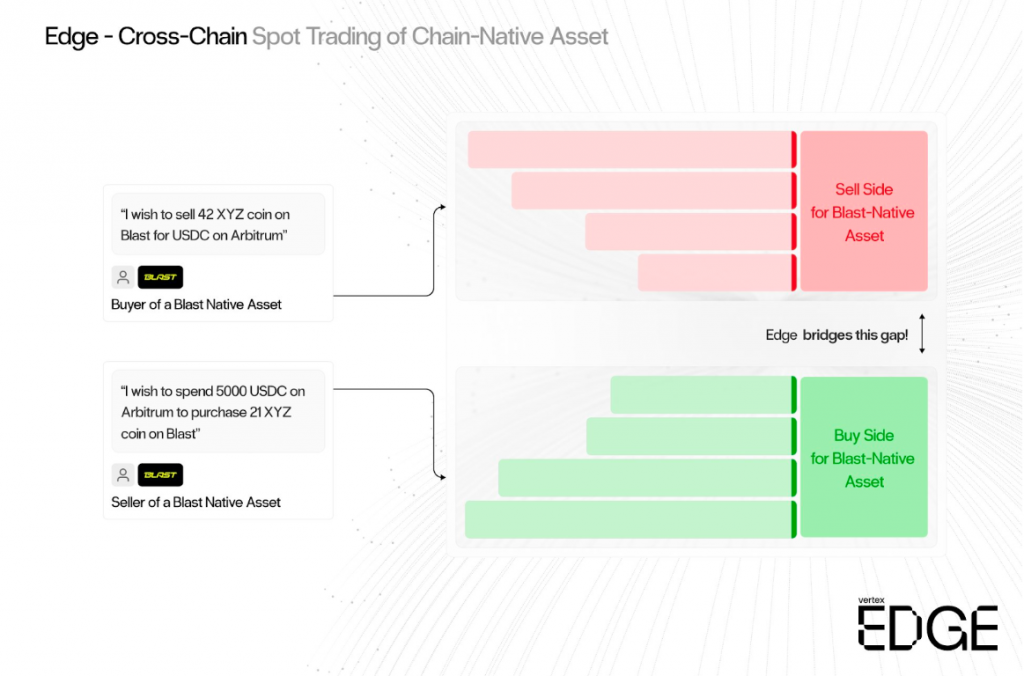
With Vertex’s perpetual markets traders can access deep liquidity pools across different chains, enabling orders from various chains to be matched simultaneously, optimizing order execution. This streamlines trading by eliminating discrepancies in funding rates across protocols on different chains due to liquidity fragmentation, enhancing overall market efficiency and trading experience.
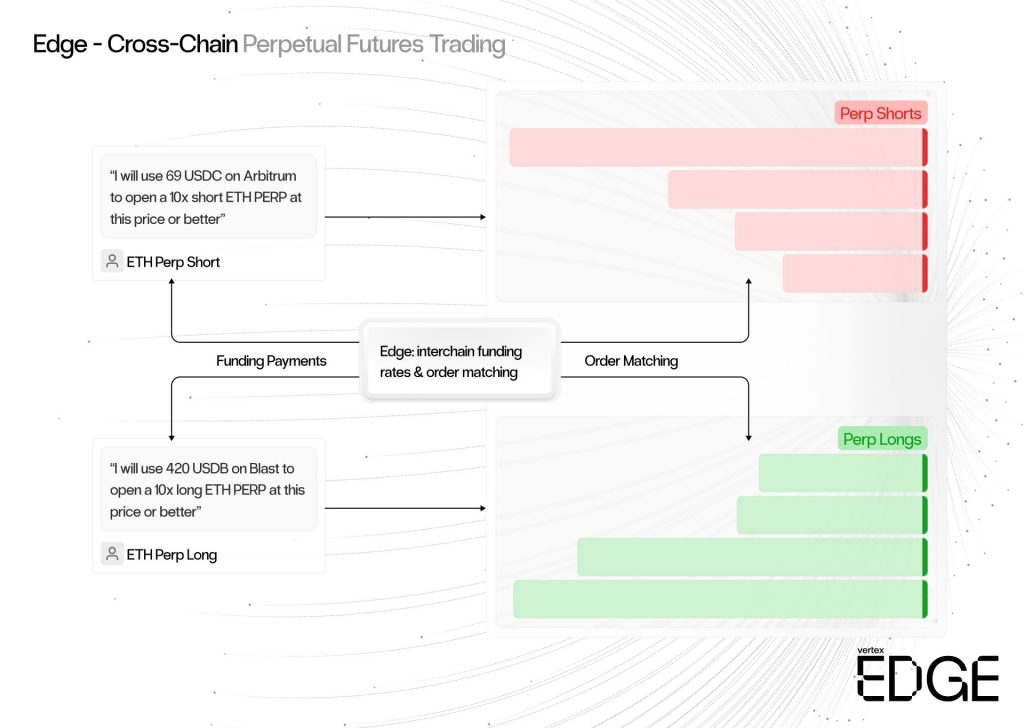
Vertex’s money market will allow for multi-chain collateral and unified interest rates, enabling users to benefit from reduced cross-chain friction and borrow/lend in a seamless way while being able to access increasing amounts of liquidity. Users participating in the money market can benefit from a unified liquidity pool, which increases the availability of assets for lending and borrowing activities. Consistent interest rates across Vertex Edge instances on different chains also promote capital flow between ecosystems, optimizing yields for passive capital allocators and providing cheap loans for active traders.
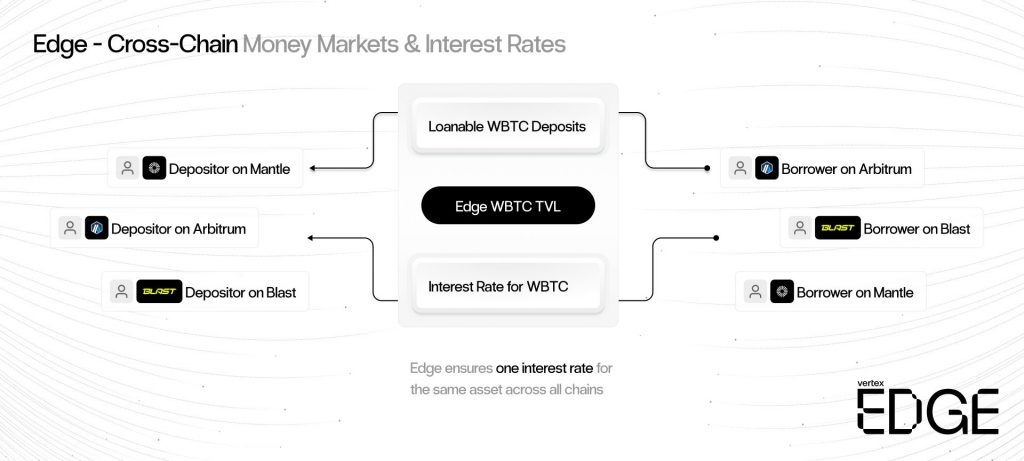
Universal Cross Margin
Vertex offers a trading feature called universal cross-margining, which consolidates liabilities across multiple open positions, enhancing capital efficiency and simplifying portfolio management.
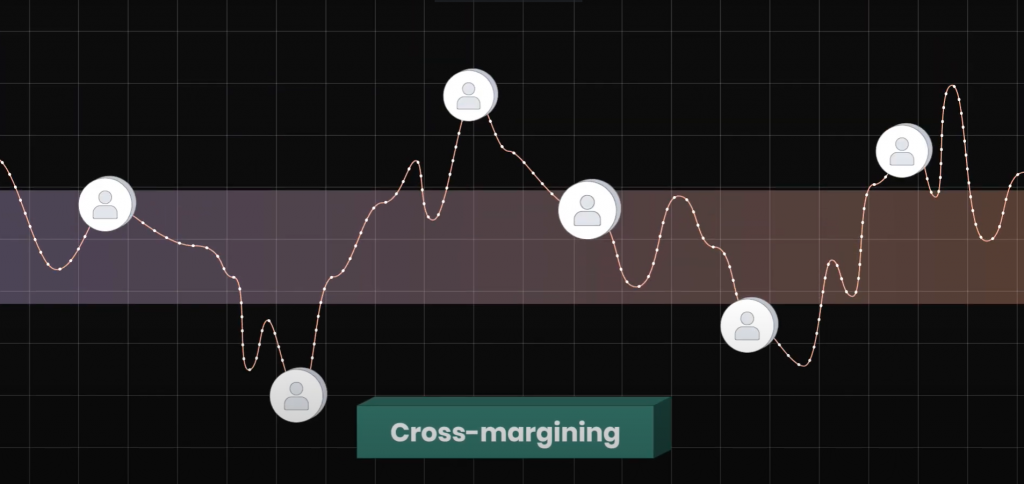
Vertex employs cross-margining as the default mode, which means that a user’s trading account combines liabilities from various positions. This consolidation allows a user’s entire portfolio to serve as collateral across multiple positions, fostering capital efficiency.
On Vertex, your portfolio is your margin – your portfolio serves as collateral across multiple open positions.

Cross Margin vs Isolated Margin

Universal cross-margin offers multiple advantages:
- Lower Margin Requirements: Cross-margining typically demands lower margin requirements compared to trading the same positions in isolated margin accounts. This means users can trade more capital efficiently.
- Automatic Risk Management: Vertex automates margin transfers between open positions to maintain required margin levels, minimizing the risk of liquidation. This automation is especially valuable during volatile market conditions and when executing complex trading strategies.
- Risk/Reward Optimization: Traders can adjust leverage across multiple positions to align with their risk preferences. This flexibility enhances capital efficiency and risk management.
- Portfolio Margining: Vertex’s cross-margin design incorporates portfolio margining, allowing unrealized profits from one position to offset margin requirements for another. This feature optimizes the use of available capital.
- Simplified Account Management: Vertex’s trading accounts provide a comprehensive view of a user’s overall risk, linking and managing all open positions in one interface. This simplifies portfolio management and risk monitoring.
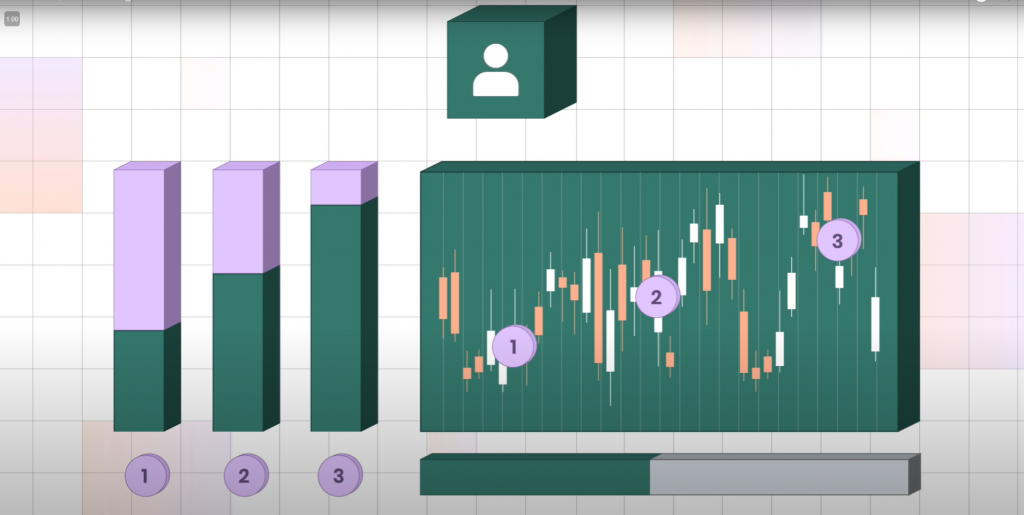
Cross-margin enables users to reduce their margin requirements since the portfolio’s risk is calculated across multiple positions. This way, open positions share capital toward each position’s margin requirements – reducing the risk of single-position liquidations while requiring a lower initial margin for each position. In Vertex, all your open positions across spot, perps, and the money market contribute to your account’s portfolio margin. This gives greater flexibility to traders and helps them reduce the risk of margin calls and forced liquidations from single position declines.
Vertex offers a clear view of your cross-margined trading account’s portfolio, including specific risk tiers. These risk tiers indicate your portfolio’s health and alert you to fluctuations in its weighted value.
The cross-margin design also allows for portfolio margin. This is similar to regular cross-margin with the difference that unrealized profits can be used to offer unrealized losses or deployed as margin for existing positions.
The portfolio health is categorized into different risk tiers, ranging from “Low Risk” to “Extreme Risk,” based on parameters like Initial Margin Usage and Health Bar Status.
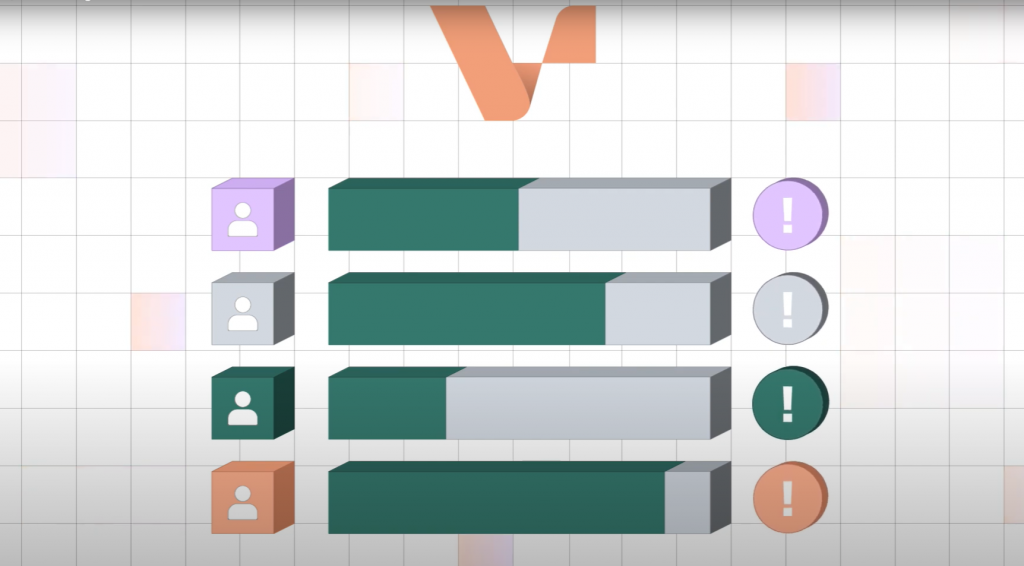
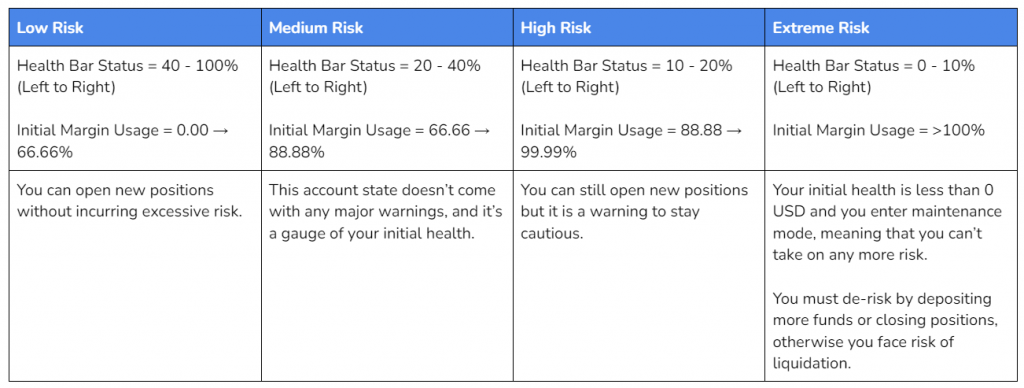
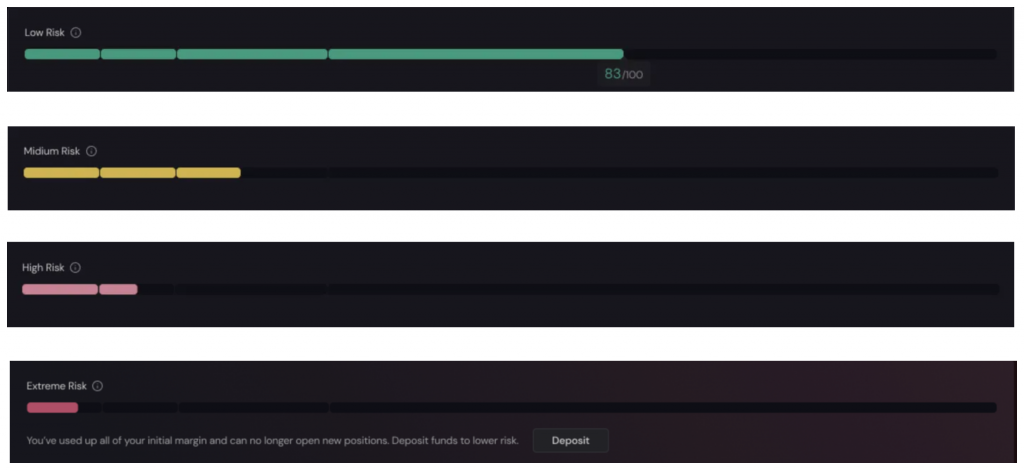
Users are encouraged to monitor their portfolio’s risk status closely. The interface will notify users as their accounts approach higher levels of risk, prompting them to take action to reduce risk or close positions. An integration with Notifi also allows users to set notification settings and get their alerts via email.
Basis Trades and Capital Efficiency
Spot and future prices are not necessarily the same and they eventually converge at maturity. It is standard among TradFi derivative trades to capture this spread and realize a profit calculated as the difference minus fees.
In crypto, perpetuals are the most common type of derivative. They are futures with no expiration and that maintain price parity with the underlying spot asset via funding rates. This mechanism balances the market such that the overweight side pays a fee to the underweight side as an incentive to bring price back to parity. Because of the absence of maturity, spot and perp prices don’t necessarily have to converge completely and can deviate for extended periods.
Perpetuals often trade at a premium compared to spot. This means that basis trades of long spot/ short perps are typically profitable positions while remaining delta neutral. For example, this means that when traders are going long and funding is positive, arbitrageurs can buy spot and short the asset on perps to earn funding.
Vertex’s universal cross-margining enhances capital efficiency for basis trades. Basis trades involve capturing spreads between spot and futures prices. Vertex provides native markets for basis trading, simplifying the process.
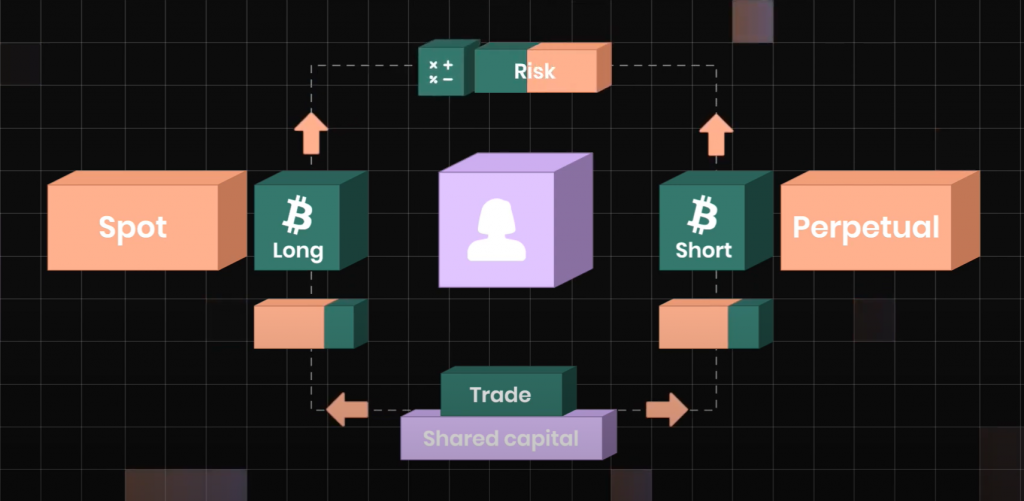
On other platforms, basis trades often require separate markets for spot and perpetual positions, leading to capital inefficiencies. For instance, if Alice is long ETH spot and short an ETH perpetual contract on another exchange, she must maintain the full margin requirement for the perpetual position, even if she has an offsetting spot ETH position.
Vertex recognizes the inefficiency and reduces the margin requirement for the ETH perpetual position. This capital-efficient approach allows traders to execute profitable basis trades with lower margin requirements. As a result of integrating a money market and spot trading right into the same protocol, Vertex offers cheaper, easier, and better arbitrage opportunities. For instance, when funding is positive, traders can now borrow $USDC, buy spot (and loop), and short the perp to capture funding and make a profit as long as the funding rate is greeted than the borrow rate.
Furthermore, the integrated money market on Vertex further enhances the basis rate, closely tethering it to borrowing rates for stables and tokens. This synergy creates profitable arbitrage conditions, attracting higher volumes and liquidity to the platform.
Portfolio Margining
With Vertex’s universal cross-margin feature, users can manage one account comprising all balances and positions, eliminating the need to switch between accounts. This streamlined approach simplifies portfolio management and optimizes capital efficiency.
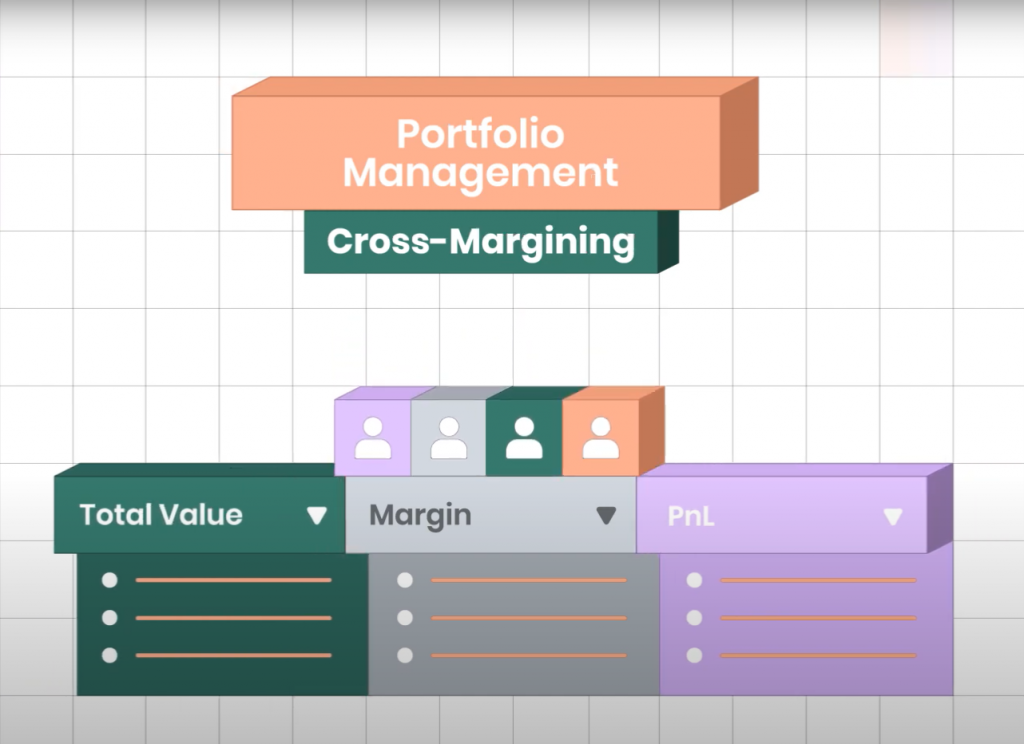
Subaccounts, Isolated Margin, and Health
In Vertex, several key features play a crucial role in managing risk and optimizing capital efficiency.
Subaccounts
Vertex allows users to create multiple subaccounts, each treated as an independent trading account. These subaccounts have their margin, balances, positions, and trade histories. Importantly, if liquidation occurs, only the assets within a subaccount are at risk, and risk is not shared between subaccounts.

By default, all subaccounts on Vertex utilize cross-margining. This default setting offers several advantages, including enhanced capital efficiency, reduced risk of liquidation for individual positions, and the ability to compound profits seamlessly.
Isolated Margin
Isolated Margin is a feature on many exchanges that allows traders to assign unshareable margin to a single leveraged position. This isolation ensures that only the capital associated with that particular position is at risk.
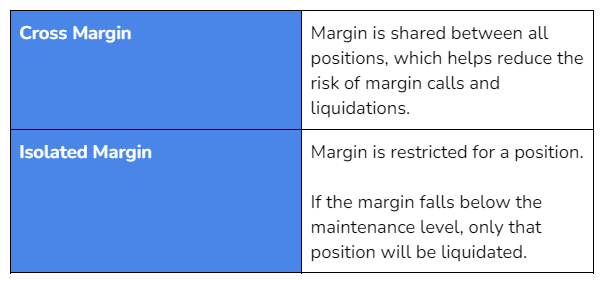
On Vertex, users can achieve similar risk isolation by creating new subaccounts for specific positions. This allows traders to compartmentalize and manage the risk associated with individual positions effectively.
Health – Weighted Margin
Vertex employs a concept called “Health,” which represents weighted margin calculations. This is a critical metric used to determine whether an account can open new positions or faces the risk of liquidation in adverse price movements.

The purpose of Health is to allow all positions in a user’s account to contribute to their margin and trading activity. This approach offers several benefits, including improved capital efficiency, enhanced risk management, greater portfolio flexibility, and increased utility for tokens.
There are two types of Health:
- Maintenance Health: When Maintenance Health falls below zero, accounts become susceptible to liquidation.
- Initial Health: Accounts cannot open new positions if Initial Health falls below zero.
In simpler terms, Maintenance Health refers to the amount of $USDC needed to avoid liquidation, while Initial Health refers to the free collateral that is available for trading.
To account for different assets’ characteristics, including collateral quality, volatility, and liquidity, Vertex assigns “weights” to all products. These weights are essential for calculating both Maintenance and Initial Health.
Each product has four weight parameters:
- maintenance_asset_weight
- maintenance_liability_weight
- initial_asset_weight
- initial_liability_weight
Maintenance health is computed using maintenance weights, and initial health is calculated using initial weights.
Spot Health
Spot assets are used as collateral on the platform and can be used to trade other assets. Their contribution to Health is calculated as follows:
For instance, consider a trade with 5 $BTC in their account and the spot price of $BTC being $10,000. This would result in the following:
- maintenance_asset_weight = 0.9
- maintenace_liability_weight = 1.1
- initial_asset_weight = 0.8
- initial_liability_weight = 1.2
Therefore:
- Initial Health = 5 * 10,000 * 0.8 = $40,000
- Maintenance Health = 5 * 10,000 * 0.9 = $45,000
Hence, since this is the only open position in the account, the user has $40,000 of collateral value available for new positions.
Perps Health
Given the embedded leverage in perps, they have a similar but slightly different calculation:
As an example, consider a user going short 5 $BTC in perps, with the price being $10,000.
- maintenance_asset_weight = 0.95
- maintenace_liability_weight = 1.05
- initial_asset_weight = 0.9
- initial_liability_weight = 1.1
Therefore:
- Initial Health = -5 * 10,000 * 1.1 – (-5 * 10,000) = -$5000
- Maintenance Health = -5 * 10,000 * 1.05 – (-5 * 10,000)= -$2,500
As a result, Vertex’s perpetuals weightings function similarly to leverage calculations on other platforms:
Special Cases: Spreads, LPs, and Large Positions
Spreads
Spreads represent offsetting positions on the same underlying asset, specifically:
- Long Spread = Long Spot + Short Perpetual (i.e., +10 BTC vs. -10 BTC-Perp)
- Short Spread = Short Spot + Long Perpetual (i.e., -10 BTC vs. +10 BTC-Perp)
For instance:
- User Position: +15 BTC, -10 BTC-Perps
- Vertex Definition: +10 BTC Spreads, +5 BTC
Given this definition, spreads are considerably less risky than the spot and perp positions on their own. As such, Vertex has the facility to attribute some health benefits to these positions.
The spread penalty is defined as a separate parameter in the system, and the spread weights for longs and shorts are defined (respectively) as:
1 – spreadpenalty and 1 + spreadpenalty
In most scenarios where the perp and spot are close to offsetting each other, the health of the spread will be roughly equivalent to the value of the spot component minus a small penalty to account for liquidity conditions.
The spread health calculation is presented below:
Continuing with the example above:
- User Position: +5 BTC, -5 BTC-Perps
- Spot + Perp Price = $10,000

LPs
LPs provide liquidity to the AMM, which follows a constant product xy=k formula. Orders can be matched against the liquidity pool or the orderbook, and takers get whichever is the best available price.
The health of a LP position is determined following the steps below:
- Assume the LP is at equilibrium (i.e. the price implied by the LP is the same as the oracle price). This is done to prevent economic attacks that manipulate the price of the LP.
- Decompose the LP into its respective components (continuing to assume an equilibrium state), and add up the health factors from there.
- Apply an additional penalty to Health.
Additional LP Penalty = (1 – LONG_WEIGHT) * AMOUNT_IN_LP * ORACLE_PRICE
This accounts for the additional risk in LPs represented by “impermanent loss” (i.e., the negative convexity). In practice, it means one’s leverage with LPs is halved.
For instance, using the asset weights from previous examples, using 5 $BTC at a price of $10,000, the initial health is $40,000.
- initial_asset_weight (wBTC) = 0.4
- initial_asset_weight (USDC) = 0.9
- LP Health = $40,000 * 0.6 = $24,000
Note that LP components are not considered in spread balances. For example, for a user who owns a $BTC LP and is short the $BTC perp, there wouldn’t be any spread balance benefit.
Liquidations and Insurance Fund
As with any other derivative platform, liquidations are a critical process to ensure the integrity and solvency of the platform. They also protect traders from excessive losses and maintain fairness in trading.
Liquidations are an automated process that closes leveraged positions when a trader’s account balance (margin) falls oto low to cover potential losses. Their primary purpose is to prevent traders from incurring debts that exceed the balance of their initial investment.
Each exchange has its own liquidation mechanisms, often defined by unique maintenance weights specific to each market. These maintenance weights determine the risk profile of a market and influence when liquidations occur.
Liquidations on Vertex are executed at the mark oracle price, derived from a third-party oracle called Stork. When an account’s maintenance health falls below zero, it enters liquidation. Next, the liquidation process takes place following a specific order:
- Orders are canceled.
- Liquidity Providers (LPs) are decomposed.
- Assets are liquidated (Spot Balances/Long Spreads/Perps).
- Liabilities are liquidated (Borrows/Short Spreads).
During liquidation, any user can purchase assets from the liquidating account at a discount or pay off its liabilities at a markup. This process continues until the underwater account’s Initial Health rises above zero.
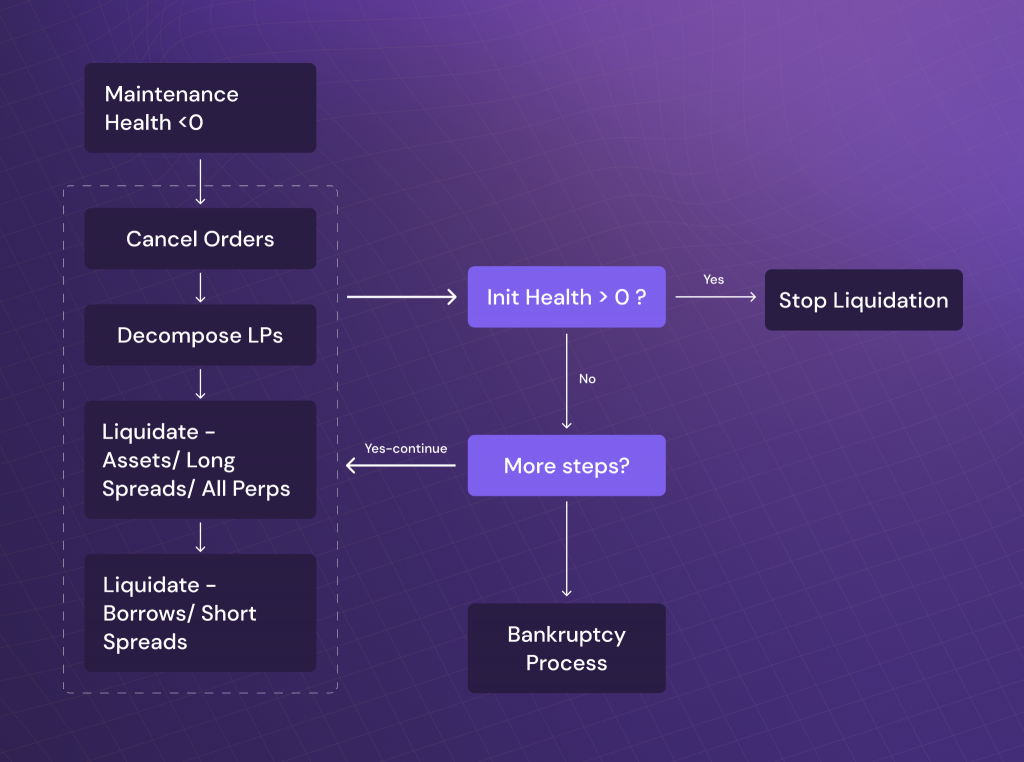
Liquidation Price Calculation
Liquidators aiming to liquidate a subaccount specify the product and amount they want to liquidate. The liquidation price for assets is set halfway between the oracle price and the price determined by the maintenance weight. In addition to that, the net price at which the product is liquidated is calculated differently for long and short positions, taking maintenance weights into account.
Long: oracle_price * (maintenance_asset_weight + 4) / 5
Short: oracle_price * (maintenance_liability_weight + 4) / 5
Liquidators generate a gross profit from liquidation, but Vertex receives 25% of this profit as fees, which are deposited into the insurance fund to protect the protocol’s health. Thus, the net profit for liquidators is adjusted accordingly.
Long: oracle_price * ((1 – maintenance_asset_weight ) / 5) * 0.75
Short: oracle_price * ((maintenance_liability_weight – 1) / 5) * 0.75
Liquidation Outcomes
Liquidators can specify any product and amount, but the total can be rounded down to minimize the impact of liquidations on users. Liquidations aim to bring the liquidatee’s Initial Health back to zero.
As a result, liquidations can result in two outcomes:
- Liquidatee receives $USDC for positive spot balances and positive PNL perps.
- Liquidatee spends $USDC to pay back negative spot balances and negative PNL perps.
Vertex ensures that the liquidatee’s USDC balance cannot go below zero to prevent incorrect assignment of losses to $USDC holders. If all liquidation options result in Outcome 2, the account is considered insolvent.
Insurance Fund
Vertex maintains an Insurance Fund that is initially seeded with funding from the core team and progressively topped up with a percentage from liquidations.
The Insurance Fund serves the purpose of being an aggregated pool of funds denominated in $USDC that are used to cover shortfalls in the event of an account going bankrupt. This helps to pay off losses and avoid socialization.
However, in cases where bankrupt accounts cannot be fully covered by the Insurance Fund, the system will attempt to socialize losses against other perpetual accounts in that market. If the account has already been settled, its losses will be socialized against all $USDC holders.
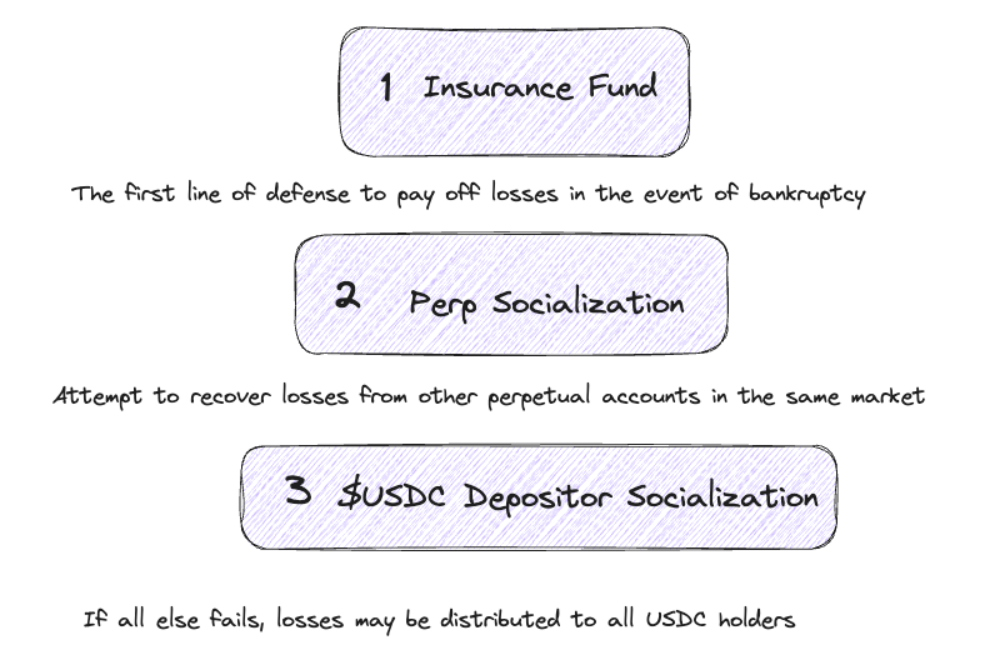
PnL Settlements
“PnL” stands for “Profit and Loss,” representing the current market value of a position minus the cost to open that position.
PnL = Market Value – Costopening
- Perp PnL: The user’s PnL across all open perps positions.
- Position PnL: The PnL of a specific position.
Traders on the platform can monitor their Perp PnL on the Portfolio Overview, and they can find the Position PnL in the Perp Positions table.
It is also possible to pin the PnL to the top of the screen on the UI, making it easy to monitor PnL across different page views.
Account Value Calculation
The value of an Account does not equate to Assets – Borrows ± Perp PnL
Instead, the Account Value is calculated as:
Account Value = Assets – Borrows ± Unsettled $USDC
This way, balances are subject to constant changes as $USDC is automatically settled on the backend from perpetual trading into balancers.
In Vertex, settlement occurs continuously, but this has no impact on the economic state of traders. However, Assets and Borrows will change over time as PnL is settled.
Perpetual Settlements – Settled & Unsettled USDC
On Vertex, open positions fall into two categories within the context of settlement: Winners and Losers.
- Winners are open positions with positive PnL.
- Losers are open positions with negative PnL.
The settlement involves a transfer of USDC from Losers to Winners, leading to corresponding balance adjustments.
Similarly, the PnL of a perpetual contract can be divided into two parts:
- Unsettled $USDC: This represents $USDC that is yet to be transferred between accounts.
- If it’s positive, it will be deposited into your $USDC balance.
- If negative, it will be deducted from your $USDC balance.
- This process is automatic and continuous.
- Settled USDC: This is PnL that has already been transferred to your current $USDC balance on the Portfolio Overview page in the Vertex app.
It’s important to note that Unsettled $USDC can fluctuate based on the volatility of positions and may not necessarily relate to the lifetime PnL of positions. Positive PnL can have negative settlements, and negative PnL can have positive settlements, depending on position duration and movements.
When closing a trade, settlements happen automatically, and any remaining unsettled $USDC will be realized into your $USDC balance. Typically, this settlement occurs within a few minutes.
You can review your settlement history on Vertex by navigating to Portfolio → History → Settlements Table on the Vertex app UI.
Users with open positions may notice changes in their $USDC balances over time. These changes occur due to PnL settlements happening on the backend. This is a normal behavior and does not affect your ability to trade.
If users have negative PnL and no $USDC in their accounts, PnL will continue to settle. However, users with positive account health will automatically borrow $USDC to cover these settlements.
Pricing – Oracles
Pricing and oracles ensure an efficient and reliable trading experience. In Vertex, oracles serve as the bridge between Vertex’s on-chain AMM and off-chain CLOB, providing pricing data that is essential for conducting on-chain operations with accuracy and speed.
Oracles in Vertex must have the following properties:

Vertex uses a multi-oracle approach such that price data is sourced from different providers.
Stork Oracle
Stork is an oracle provider designed for ultra-low-latency and high-performance price feeds compatible with the EVM.
Stork utilizes ultra-fast WebSockets across multiple regions and node providers to provide millisecond-level reference prices, similar to traditional centralized exchanges. It also enables off-chain initial processing and subsequent on-chain price updates, which reduces computational complexity and costs.

Publishers in the Stork network are chosen based on their ability to provide low-latency price updates reliably. Also, each publisher can contribute an index price for the markets supported by Stork, although not all publishers may converge their price calculations.
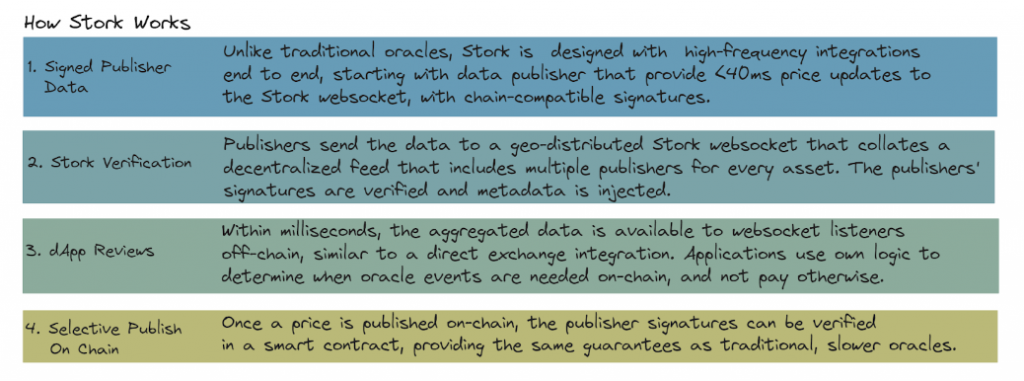
Vertex uses 3 different price feeds via Stork:

- For liquidations, Vertex utilizes the Spot Oracle Price (#1) and the Perp Oracle Price (#2) to calculate a trader’s account value.
- For funding rate calculations, Vertex uses a TWAP of the Orderbook Price on Vertex (#3), known as the mark price, and a TWAP of the Spot Oracle Price (#1).
- An independent oracle price also exists for $USDC, ensuring functional trading behavior even if USDC’s peg to USD is disrupted.
Note that Vertex displays prices quoted against $USDC, not USD. Besides, the protocol does not assume a 1:1 peg between $USDC and USD.
Chainlink Data Streams
Chainlink Data Streams are used to deliver sub-second resolution data, allowing users to access high-fidelity market information quickly and accurately.
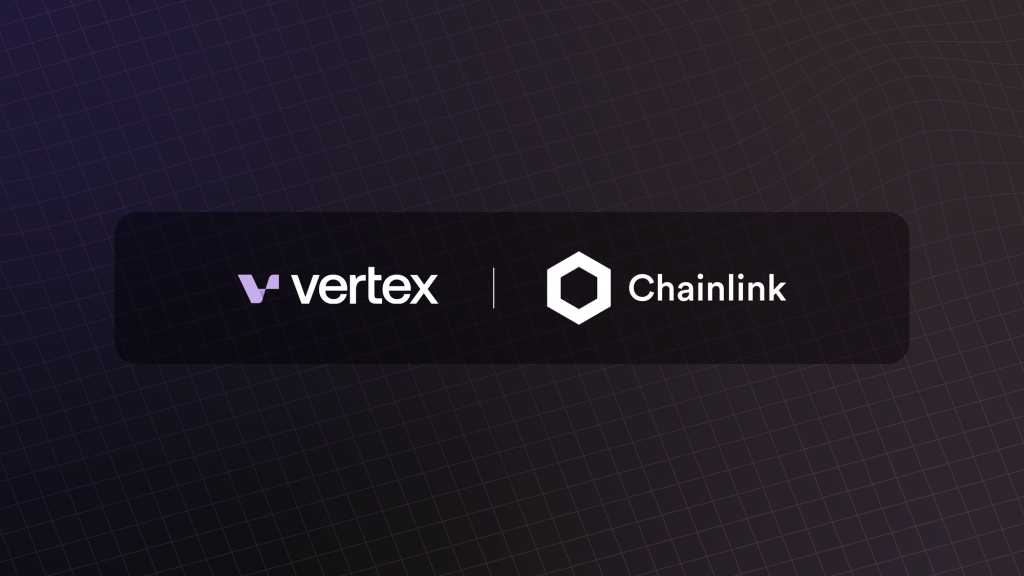
Chainlink Data Streams are known for their robust performance and security. They are designed to maintain their reliability even during unexpected events such as exchange downtime, flash crashes, and data manipulation attacks via flash loans. This ensures that Vertex Protocol users can trade with confidence.
Chainlink Data Streams use conflict-of-interest-free data sources and a commit-and-reveal architecture to protect traders and liquidity sources against malicious price manipulation and information arbitrage. This adds an additional layer of security.
Why the Project was Created
Vertex’s mission is driven by the recognition of centralization risks that continue to plague the cryptocurrency market. The contagion events of 2022 exposed vulnerabilities in the traditional financial system’s influence over the crypto industry. The series of insolvencies and misaligned incentives between third-party custodians and their customers served as a stark reminder of the moral hazard present in traditional finance.
DEXs have long been championed for their ability to empower users with control and autonomy. They mitigate the principal-agent problem posed by centralized actors and eliminate the need for trust in third parties. However, DEXs have faced obstacles hindering their broader adoption.
Despite the revelations of centralization risks, centralized exchanges (CEXs) have continued to dominate crypto trading. They offer additional features, smoother fiat on/off ramping, lower latency, and superior liquidity. Incumbent DEXs have struggled with scalability, user experience, and capital efficiency barriers, limiting their appeal to the average trader.
It is against this backdrop that Vertex emerged with a clear and transformative vision. The project seeks to redefine the narrative by eliminating the trade-offs users face between control and performance when choosing between CEXs and DEXs.
Vertex’s mission is to bring the performance and features of centralized exchanges on-chain while preserving the core benefits of self-custody, transparency, and decentralization inherent to DeFi. The project achieves this by offering a vertically integrated DEX on the Arbitrum network, incorporating spot trading, perpetual contracts, and an integrated money market into a unified platform.
Sector Outlook
Vertex strives to provide a seamless, decentralized trading experience that combines the performance and features of CEXs with the benefits of self-custody, transparency, and autonomy inherent to DeFi.

Traders can execute spot and perpetual trades, manage portfolio margins efficiently, and participate in the integrated money market, all while maintaining control of their assets. The idea is that users no longer compromise control for performance and features.
Vertex stands out as a DEX that not only offers a versatile trading experience but also bridges the gap between centralized and decentralized exchanges. Its use of Arbitrum’s L2 scaling and innovative on-chain AMM, combined with off-chain order book technology, positions it to deliver lightning-fast performance while preserving the user-centric principles of DeFi.
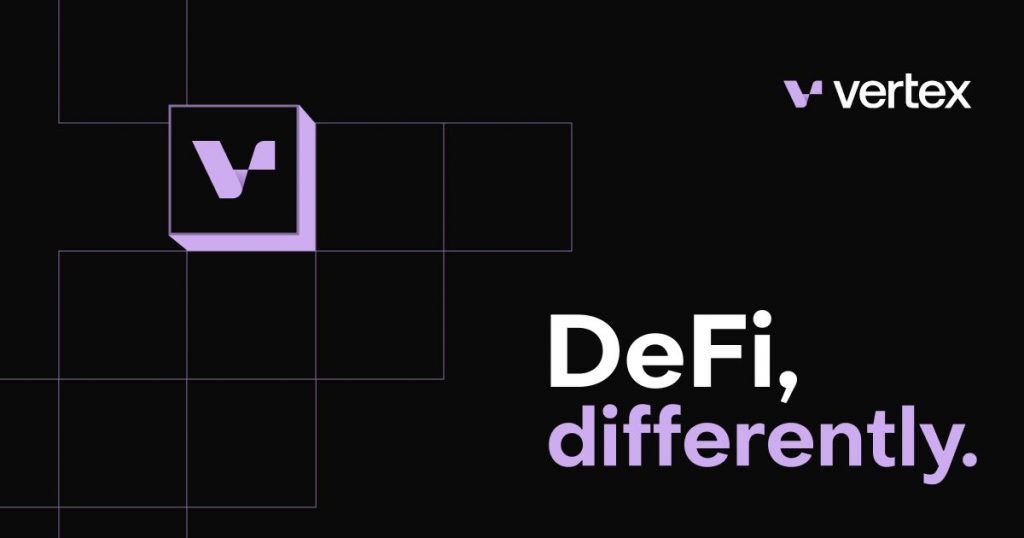
Unlike other projects focused on derivatives, Vertex aims to simplify the trading experience. Users no longer need to switch between various decentralized applications (dApps) for different trading functions. Instead, they can trade, earn, and borrow all within the Vertex DEX, offering a seamless and comprehensive trading ecosystem.
The Flaws of Centralized Exchanges
Differences between Centralized Exchanges (CEXs) and Decentralized Exchanges (DEXs) revolve around trade-offs that impact trading performance, particularly concerning spreads and slippage. Both types of trading venues aim to provide liquidity through tight spreads and low slippage, but they do so within their respective limitations, allowing users to choose the platform that aligns with their preferences.
Currently, CEXs hold a significant advantage in terms of user adoption and volume. They offer a familiar and efficient trading experience that caters to a broad audience. However, recent incidents like the FTX debacle have triggered a shift in user preferences. Factors such as self-custody, transparency, and autonomy in DeFi have gained traction, prompting users to explore decentralized alternatives.
anced security, and innovative trading options. These integrations play a crucial role in Vertex’s mission to provide a comprehensive and user-friendly DeFi platform.
CEXs typically offer more significant liquidity, making it easier for traders to execute large orders without significant slippage. They also provide a wide range of trading options, including perpetual contracts, spot markets, and cross-margining, catering to different trading preferences. Additionally, high-frequency traders find CEXs attractive due to their infrastructure and speed, allowing for algorithmic trading strategies.
DeFi, on the other hand, introduced innovative financial products and autonomy, attracting users interested in self-custody and transparency. Automated Market Makers (AMMs), in particular, gained widespread attention, enticing retail users with passive liquidity provision and the ability to trade long-tail assets.
However, AMMs faced challenges, including gas fees and the erosion of liquidity provider profits due to arbitrage and Miner Extractable Value (MEV). These issues prompted users, especially high-frequency traders, to seek alternatives on CEXs, which offered better infrastructure and capital efficiency.
While efforts have been made to improve DEXs, including the development of central limit order book (CLOB) exchanges and off-chain order books to minimize MEV and enhance trading execution, CEXs still dominate. In fact, most DEXs prioritize either spot or perps, but not both.
Vertex gains a competitive advantage by offering spot, perps, and a lending market all in one platform. Additionally, it bridges the gap between CEXs and DEXs, offering self-custody, MEV mitigation, integrated products, cross-margining, liquidity, HFT-friendly APIs, and fast order execution. It seeks to provide users with the benefits of both worlds, making it a potential solution to the challenges faced by DEXs.
Orderbooks and AMMs
Vertex introduces a Hybrid Orderbook-AMM. This represents a solution that bridges the gap between the limitations of Decentralized Exchanges (DEXs) and Centralized Exchanges (CEXs).
In crypto and on-chain environments, liquidity is a paramount concern, defined by tight spreads and minimal slippage. Both DEXs and CEXs strive to provide liquidity to users, but their approaches differ significantly. Vertex’s design, however, seeks to harmonize the best features of both worlds.
Central to this design is the consideration of three core technical factors: speed and performance, flexible liquidity expression, and easy access to market information. The Continuous Limit Order Book (CLOB) structure emerges as the most effective exchange model, a model that dominates both CEXs in the crypto world and traditional finance exchanges.
Despite its advantages, on-chain order book solutions in DeFi face scalability issues due to the inherent limitations of blockchain technology. Scalability, low latency, and the threat of Miner Extractable Value (MEV) pose challenges to the effective operation of on-chain order books.
In response to these challenges, DEXs have gravitated toward two main approaches. The first involves Automated Market Makers (AMMs), which offer passive retail trading venues but often suffer from latency and scalability issues. Despite their limitations, AMMs remain dominant in the DEX space due to their popularity among traders.
The second approach seeks to bypass on-chain limitations by utilizing off-chain order books for trade matching. However, this approach still maintains on-chain execution and asset custody to preserve DeFi’s self-custodial advantages while avoiding performance and MEV issues.
Vertex’s solution takes a unique approach by combining the benefits of an on-chain constant product AMM with an off-chain order book known as the “sequencer.” The risk engine remains entirely on-chain, ensuring transparency and trustlessness. In the default state, trades occur on the on-chain AMM, but traders can access the Vertex API to execute trades directly from the off-chain order book, achieving impressive speeds of 10 – 30 milliseconds, competitive with most CEXs.
This hybrid model offers several advantages to Vertex users. It enhances execution quality by allowing market makers to provide tighter prices with less risk, resulting in reduced slippage. It accommodates retail users, enabling them to provide passive liquidity and engage in market-making and yield farming strategies. Importantly, it ensures trustlessness, as the AMM provides an alternative trading pathway even if the sequencer order book experiences issues.
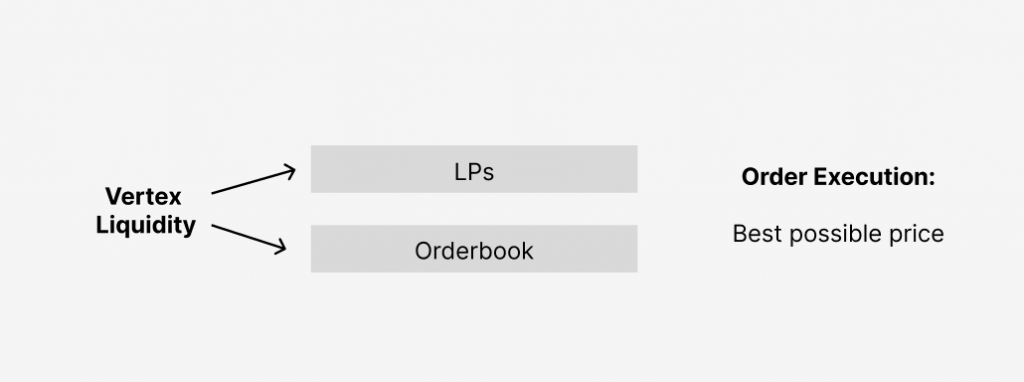
Furthermore, Vertex’s AMM design leverages the x*y=k pools architecture for both spot and perpetual markets. Traders can contribute liquidity to different pools, and this liquidity combines with automated trader liquidity via the sequencer. Trades are executed at the best possible price, taking advantage of both limit orders and liquidity provider positions. This approach ensures continuous liquidity availability and benefits both illiquid and liquid assets.
In summary, Vertex’s Hybrid Orderbook-AMM design offers the best of both worlds: the performance and features of popular CEXs and the on-chain advantages of DeFi. By addressing the limitations of existing exchange models, Vertex aims to provide traders with an unmatched trading experience, bringing liquidity, flexibility, and trustlessness to the forefront of cryptocurrency trading.
Appchains and Latency Challenges
Building appchains for decentralized platforms involves a tradeoff between achieving low latency and maintaining the core principles of blockchain technology. Appchains serve as an intermediate execution environment within a decentralized ecosystem. While distributed blockchains offer unparalleled security and decentralization, they inherently introduce latency due to the need for consensus among globally distributed nodes. This latency can be a significant challenge when it comes to high-frequency trading, where speed is of the essence.
To address the need for low latency, one approach is to collocate servers in a single location. However, this approach raises questions about decentralization, as it can concentrate control and undermine the fundamental ethos of being a blockchain—a globally distributed network.
When it comes to building a DEX, Vertex acknowledges that faster blockchains can empower market makers by allowing them to place orders at the top of the order book with greater confidence, resulting in better prices and execution for users. For instance, appchains like Hyperliquid still operate with latencies ranging from 200 to 900 milliseconds, which are more than 10 times what Vertex can offer. In comparison, their setup aims for super-low latency, emphasizing the importance of an optimal user experience, particularly for achieving deep liquidity in trading.
However, there’s a notable tradeoff involved. While faster execution is vital for traders, running a decentralized appchain on top of a L2 solution may compromise overall performance and speed. This tradeoff suggests that the need for speed could outweigh the security benefits typically associated with a distributed execution environment.
In the case of Vertex, their setup prioritizes order book security. Real-time transactions are closely monitored by professionals, contributing to the trust users place in the order book’s integrity. Trust in orderbook security is further reinforced through social enforcement mechanisms and open liquidations, ensuring that users have confidence in the trading environment.
This way, market makers would immediately notice any manipulation or reordering of transactions, leading to a loss of liquidity. Lower latency also enables market makers to provide better pricing by taking more risk. This would prioritize time preferences on the market and ensure fair execution for all traders. Similarly, by being fast, consistent, and predictable, liquidity providers can offer better liquidity and pricing to traders.
Unifying Cross-chain Liquidity
With Edge, Vertex addresses the pressing issue of fragmented liquidity across various chains, serving as a synchronous orderbook liquidity layer that seamlessly integrates liquidity from multiple chains. By fusing liquidity from supported Edge chains and aggregating it at the Vertex sequencer level, Vertex Edge eliminates the fragmentation of liquidity pools seen with traditional cross-chain solutions.
The Vertex sequencer, enhanced by Edge, functions as a virtual market maker between exchange venues on different chains. It matches inbound orders from one chain against liquidity from multiple chains concurrently, optimizing order execution and enhancing trading efficiency for users. This approach ensures that users can access deep and liquid markets without the need to navigate between different chains.
As Vertex instances proliferate across ecosystems and usage grows, a mutually beneficial scaling of liquidity manifests, benefiting all participants in the Vertex ecosystem, whether they are trading spot, perps, or borrowing liquidity from the money market.
Contrast this with other DEXs that rely on deposit contracts or appchains. Those DEXs are effectively taking activity off other chains. However, unlike such competitors, Edge maintains all activity on the host chain, offering a win-win scenario for all parties involved: users get the experience they want, liquidity improves everywhere, and chains improve their user retention. This results in alignment between protocols and chains, instead of competition and endless pressure to capture users and liquidity through unsustainable incentives.
Potential Adoption
Vertex’s core value proposition lies in delivering the performance and usability that centralized competitors offer while maintaining on-chain and self-custodial principles. It empowers users to take control of their assets, facilitating lightning-fast trades, universal cross-margining, and a customizable, user-friendly trading interface.

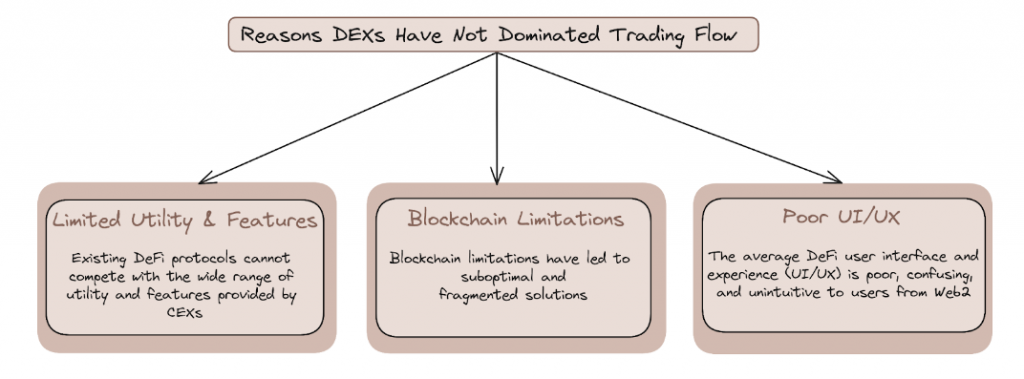
With Vertex, users no longer need to switch between multiple DeFi applications (spot AMMs, perpetual DEXs, money markets…) to perform actions such as buying and selling, going long or short derivative contracts with leverage, borrow or lend assets…
Even though some of the perp DEXs have already gained their first users and managed to retain them, Binance still holds more than half of the market share. Projects like Vertex aim to reduce their share of the pie and bring more users on-chain by offering a similar UX that also allows for unique offerings thanks to their architecture and suite of products.
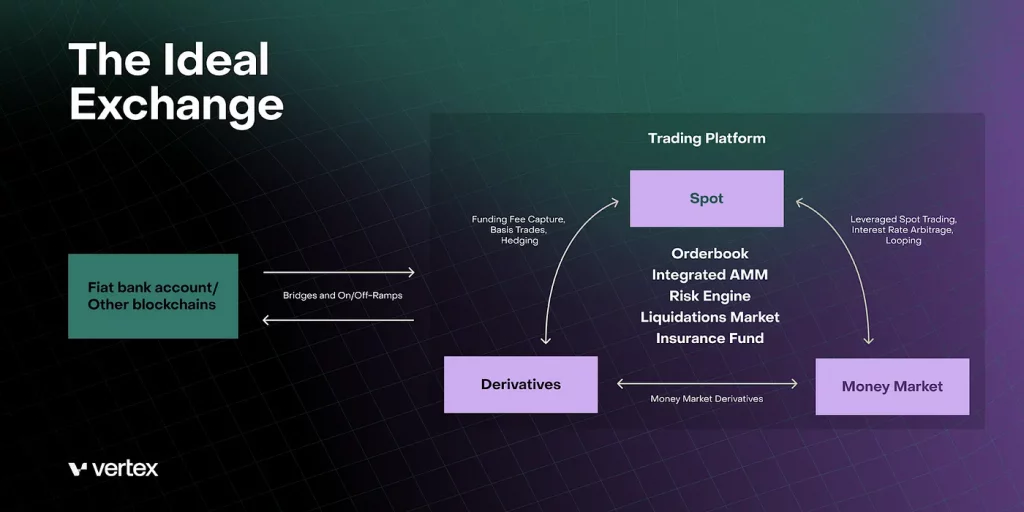
Besides being a more convenient place to perform on-chain actions, offering multiple products from a single platform reduces costs for users and offers increased capital efficiency, aggregating liquidity conditions and offering better pricing with narrower spreads.
Each component of the Vertex stack coalesces into a single unified platform that solves the limitations of siloed DEX models and allows for each of the core products to amplify the strengths of each other. The resulting hybrid AMM and orderbook DEX maximizes performance, improves liquidity conditions, and offers a more diverse product suite.
Universal-margined accounts are one of the most demanded and popular features in CEX, but they have not been offered to DeFi users up until now. This first-mover advantage can simplify Vertex’s job to onboard new traders who are already used to trading on a CEX.
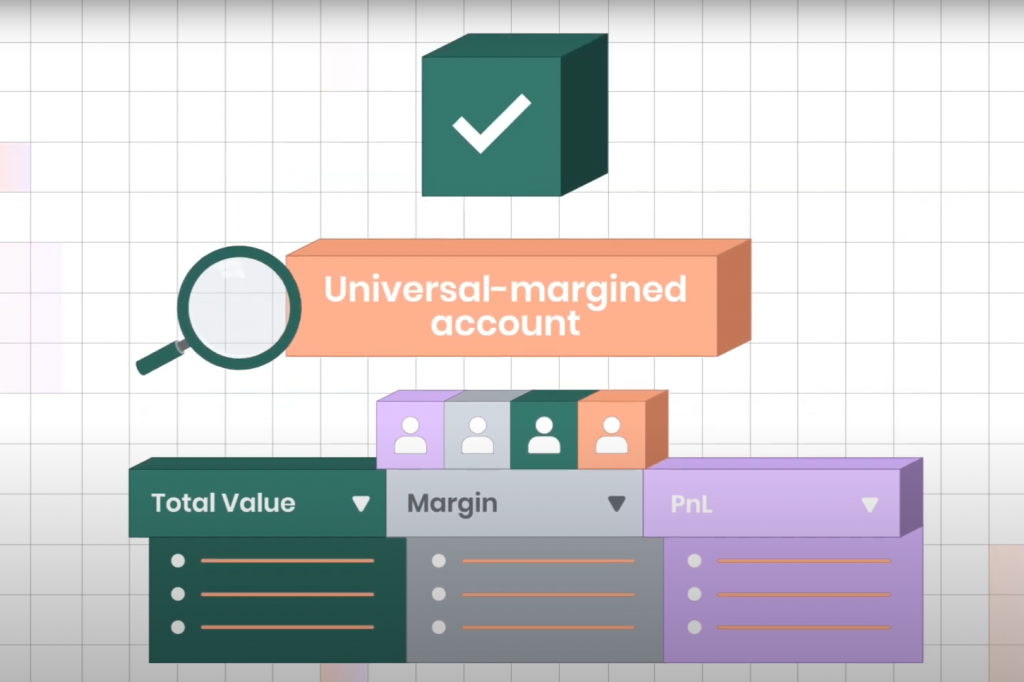
Universally cross-margined trading accounts can be beneficial for both sophisticated and retail traders for several reasons, including:

When it comes to competing versus other DEXs, the goal is to establish a moat around more capital efficiency, low latency, better liquidity conditions for trading, and more flexible ways to optimize for portfolio management.
Even though Vertex is not currently offering very high levels of leverage such as the 50 allowed on different platforms, the vertically integrated product suite enhances their value proposition versus other competitors like GMX or similar clones which rely on external oracles for pricing.
It is also worth noting that Vertex does not aim to increase the amount of revenue generated from trading fees by setting high numbers that might deter traders from using the platform. Instead, the long term goal is to attract different market segments and clients while maintaining low fees. Because of that, Vertex attempts to charge fees as low as possible to increase market share making it more appealing for institutions and professional trading firms.
Chains
Vertex is currently live on Arbitrum and has plans to deploy on other chains in the future.
One notable feature is the introduction of cross-chain deposits through a partnership with Axelar, utilizing Axelar’s Squid Router to allow users to seamlessly deposit assets from various chains such as Ethereum, Optimism, BNB Chain, Polygon, Fantom, Mantle, Base, and Avalanche, directly into their Vertex accounts. The process is swift, averaging around 2 minutes, and does not require users to leave the Vertex app, ensuring a seamless user experience.

As an example, the graphic above illustrates the Vertex Protocol’s cross-chain deposit flow, where users can easily transfer $wBTC from Ethereum and receive $USDC on Arbitrum, which is then automatically deposited into their Vertex account.
Additionally, Vertex Edge ensures that liquidity across different chains can be unified in a single unified layer orchestrated by Vertex’s Synchronous Orderbook powered by its sequencer.
Using the Protocol
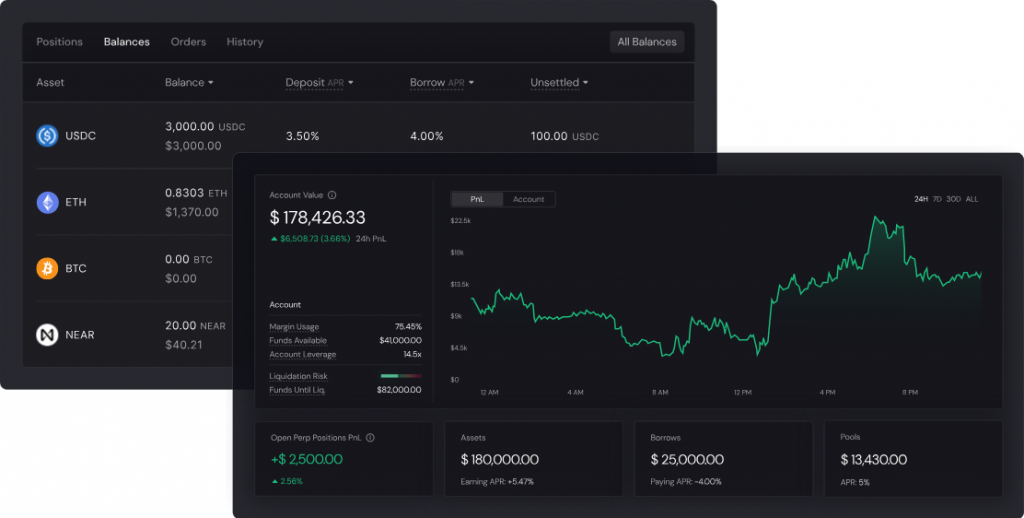
Customizable Experience
Users can customize the trading interface based on their preferences, adjust the trading terminal layouts, set custom notifications, risk management signals…
Spot Trading
Spot trading on Vertex is straightforward and efficient, allowing traders to buy and sell actual assets against $USDC.
Traders can opt to trade with or without leverage and choose between market or limit orders. The platform also offers the option to borrow $USDC or the asset being sold, enabling traders to trade sizes larger than their current holdings.
After placing a trade, traders can manage their positions or cancel open orders easily. Vertex does not currently support Trigger order types like Take Profit (TP) and Stop Loss (SL) without 1CT enabled. However, traders can manually approximate a Take Profit by placing a limit order against existing positions. The platform plans to introduce Stop Loss orders at a later date.
Perps Trading
Perpetual contracts on Vertex offer a way to trade derivative contracts on underlying spot assets with leverage. This function amplifies both profits and losses and is suited for experienced traders. Vertex’s perpetual markets allow traders to long or short contracts against $USDC, providing a dynamic trading environment. Users can select their trade leverage, place market or limit orders, and manage their positions with ease. Although Vertex currently doesn’t offer trigger order types like Take Profit and Stop Loss without 1CT enabled, the platform is actively working on introducing these features.
One-Click Trading
One-Click Trading (1CT) on Vertex significantly enhances the trading process and user experience by eliminating the need for repeated approval transactions.
A single approval transaction at the beginning of a session enables traders to perform any subsequent action within the Vertex app without additional approvals.
This feature, which improves the platform’s efficiency and security, closely aligns the trading experience with that of centralized exchanges. Importantly, when 1CT is enabled, it facilitates the setting of TP and SL orders for both Spot and Perpetual trading, ensuring a seamless and efficient trading process. The feature includes a ‘Remember Me’ option for session continuity and offers the flexibility to switch modes based on trader preferences.
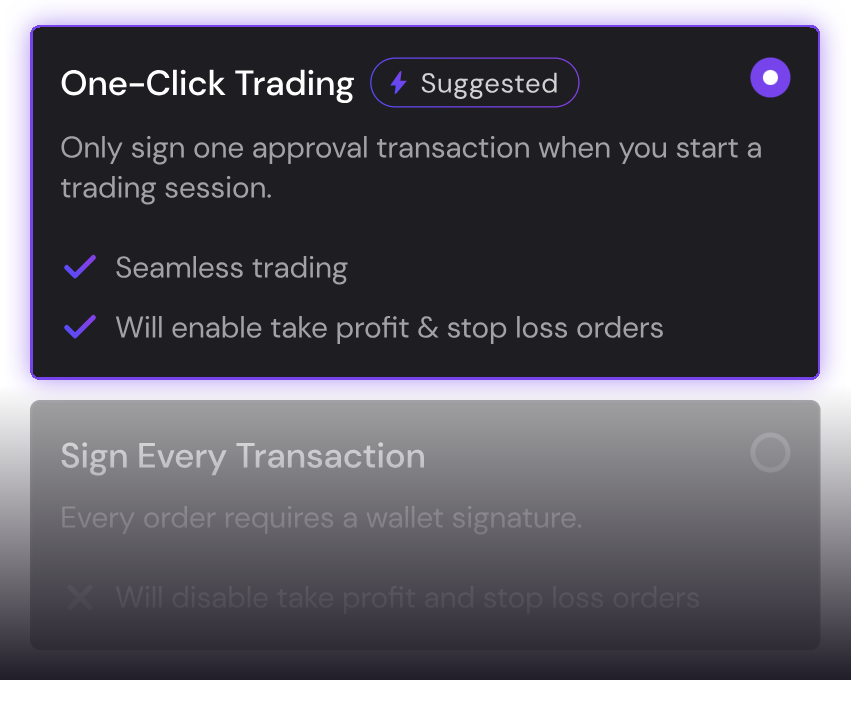
Mobile
Vertex mobile allows users to keep track and monitor their positions on the move.
Notifications
Vertex has introduced notifications feature through its partnership with Notifi, bringing push notifications directly to traders. This integration marks a significant step forward in enhancing the trading experience on Vertex, providing real-time updates and alerts that keep users abreast of vital account activities and market movements.
Getting Started with Notifications
Setting up notifications on Vertex is a straightforward process, designed to integrate seamlessly with users’ preferred communication channels. Here’s how to activate this feature:
- Activation: Users can initiate the setup by clicking the notification bell icon located at the top right corner of the desktop interface. (Note: Mobile functionality is under development and will be available soon.)
- Channel Selection: Users are prompted to enter the accounts where they wish to receive notifications, such as Discord, Email, and Telegram.
- Approval Transaction: A transaction is required to authorize the chosen notification settings.
- Alert Preferences: Users can then select the types of alerts they wish to receive, tailoring the notification experience to their specific needs.

Available Alerts
Upon launch, Vertex users can opt-in to receive a variety of alerts:
- Vertex Announcements: Stay updated with the latest features, market additions, special events, reward programs, and partnerships.
- Order Fills (Partial & Full): Receive instant notifications when your orders are partially or fully executed.
- Liquidation Events: Get alerted promptly on any liquidation events affecting your positions.
- Margin Usage: Monitor your initial margin usage, with alerts sent out when it reaches a specified percentage. Users can choose from pre-set options or set a custom percentage threshold.

Viewing Alert History
Vertex also provides an easy-to-access history of past alerts. By clicking on the notification icon, users can view a scrollable page of their alert history, ensuring they never miss an update or alert.

Real-Time Updates
The Notifi integration ensures that alerts are processed on a 1-minute polling schedule. This means that notifications, whether they pertain to order fills, margin thresholds, or any other specified alert, will be delivered within 1 minute of the event occurring. This timely delivery ensures that traders can react swiftly to market changes and account notifications, enhancing their trading strategy and portfolio management.
Cross-chain Deposits
Vertex simplifies the process of depositing assets from various chains through its native integration with Axelar’s Squid Router, allowing users to seamlessly deposit assets from various chains such as Ethereum, Optimism, BNB Chain, Polygon, Fantom, Mantle, Base, and Avalanche, directly into their Vertex accounts.
The process is swift, averaging around 2 minutes, and does not require users to leave the Vertex app, ensuring a seamless user experience.

As an example, the graphic below illustrates the Vertex Protocol’s cross-chain deposit flow, where users can easily transfer $wBTC from Ethereum and receive $USDC on Arbitrum, which is then automatically deposited into their Vertex account.

This way, traders can seamlessly bridge and deposit assets from supported chains directly into their Vertex trading accounts. This feature eliminates the need for multiple steps and interfaces, offering a straightforward and time-efficient deposit process.
Deposits and Withdrawals
Vertex simplifies the process of depositing and withdrawing assets, ensuring that users can manage their funds with ease.
When depositing, users initiate the process through a user-friendly interface, selecting their desired asset from a dropdown menu and specifying the amount they wish to deposit. The system may require approval for certain assets, establishing a spending cap for future transactions without additional approvals. Once approved, the deposit is confirmed in the user’s wallet, reflecting immediately in their Vertex account.
Withdrawing follows a similar intuitive process. Users select the ‘Withdraw’ option associated with the asset of their choice and specify the amount they want to withdraw, up to the maximum amount available. After confirming the withdrawal in their wallet, the transaction is executed swiftly, ensuring that users have full control and quick access to their funds.
Borrowing and Repaying
Vertex’s integrated Money Market allows traders to borrow assets against their portfolio, enabling the withdrawal of borrowed assets from Vertex’s smart contracts. Traders can easily manage their borrowed assets and repay their loans through the platform’s intuitive interface.
Portfolio Management
Vertex’s Portfolio Management offers a comprehensive overview of the user’s entire portfolio, including high-level insights and specific metrics like account value, PnL, and performance charts. Detailed insights into margin usage, available funds, and liquidation risks provide a clear understanding of the portfolio’s health. Activity tables display account totals for balances, open positions, and LP positions, allowing users to manage their assets and positions effectively.
Margin Manager
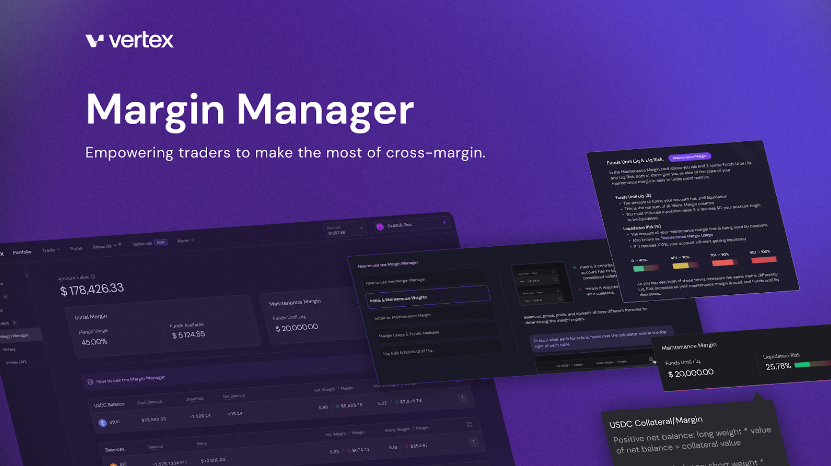
The Margin Manager of Vertex Protocol serves as an advanced tool, offering users a holistic overview of their account’s margin influence. It consolidates information about users’ balances and positions, clarifying their contribution to overall margin requirements.
This comprehensive view is vital for maintaining robust risk management strategies, as it assists users in steering clear of liquidation by providing a clear understanding of initial and maintenance margin levels.
The feature also facilitates quick actions for balance and position management, enhancing the user’s trading strategy and risk management capabilities.

Developers and Integrations
Vertex understands the importance of catering to high-frequency traders (HFT) and automated trading strategies. To this end, it offers a powerful Vertex API and SDK, enabling HFTs and automated traders to operate effectively. Notably, Vertex optimizes gas efficiency by excluding low-value and extraneous transactions, making it adaptable across various EVM-compatible chains.
Trigger Orders
Vertex offers sophisticated trigger orders, including Stop-Loss (SL), Take-Profit (TP), and Stop-Market Orders, providing traders with advanced risk management tools. These conditional orders automatically trigger a buy or sell action once the market reaches a specified price, known as the trigger price, allowing for predetermined entry and exit points without the need for constant market monitoring.
Types of Trigger Orders on Vertex:
- Stop-Market Orders enable traders to set a trigger price, executing a market order once the price is reached. These orders are particularly useful for capitalizing on market trends without the need for continuous price tracking. However, it’s important to note that stop-market orders are not linked to existing positions and are executed as new buy/sell orders, subject to full execution or cancellation (Fill or Kill). Traders can customize slippage tolerance to ensure the order is executed within an acceptable price range.
- Take Profit (TP) Orders are set to automatically close or exit a profitable position once it reaches a certain price level. These orders are linked to existing positions and are executed in the opposite direction of the open position. TP orders are classified as “Taker” orders, meaning they take liquidity from the order book. Similar to stop-market orders, TP orders are also subject to the Fill or Kill rule, ensuring full execution or cancellation.
- Stop-Loss (SL) Orders are designed to limit potential losses by automatically executing a market order when the asset price hits a predetermined level. These orders are beneficial for managing risk and defending a position from liquidation. Like TP orders, SL orders are linked to open positions and executed in the opposite direction to manage exposure effectively.
To utilize these trigger orders on Vertex, the One-Click Trading mode must be enabled, streamlining the trading experience by reducing the need for multiple approvals. Vertex ensures that traders have a wide array of tools for effective risk management and strategy implementation.
Guide on Utilizing Trigger Orders:
Setting Up TP/SL Orders:
- Navigate to the Perp Positions table.
- Use the ‘+ Add’ option to set up a TP/SL order for a specific position.
- Choose the trigger price, based on either the Mark Price or the Last Price.
- Confirm and place your TP/SL order. The system automatically reflects the new TP/SL in the positions table.
Placing Stop-Market Orders:
- Select ‘Stop’ as the order type in the trading form.
- Input the trigger price and the order size.
- Confirm the order. Vertex supports Fill or Kill (FoK) execution, meaning the order must fill entirely or be canceled.
Managing Orders:
- TP/SL orders auto-cancel if users want to modify the size of the associated position.
- Stop-market orders do not auto-cancel and must be manually canceled if no longer needed.
While trigger orders are a powerful tool for risk management, it’s crucial for traders to understand that these orders do not guarantee execution at the trigger price, especially in volatile markets. Traders are advised to regularly monitor their orders and manage their positions proactively to align with their trading strategy and risk tolerance.
Vertex API and SDKs
- EIP-712 executes (place/cancel orders, withdraw collateral, liquidate subaccounts, mint/burn LP…)
- Queries (contracts, nonces, orders, subaccount info, market liquidity, symbols, market prices, max/min order size, max withdrawable, max LP mintable, fee rates, health groups, linked signers, insurance…)
- Subscriptions (authentication, available streams, events, rate limits…)
Business Model
When users execute trades on the platform, they are charged a fee, which is typically a percentage of the transaction amount. These fees contribute to the platform’s revenue.
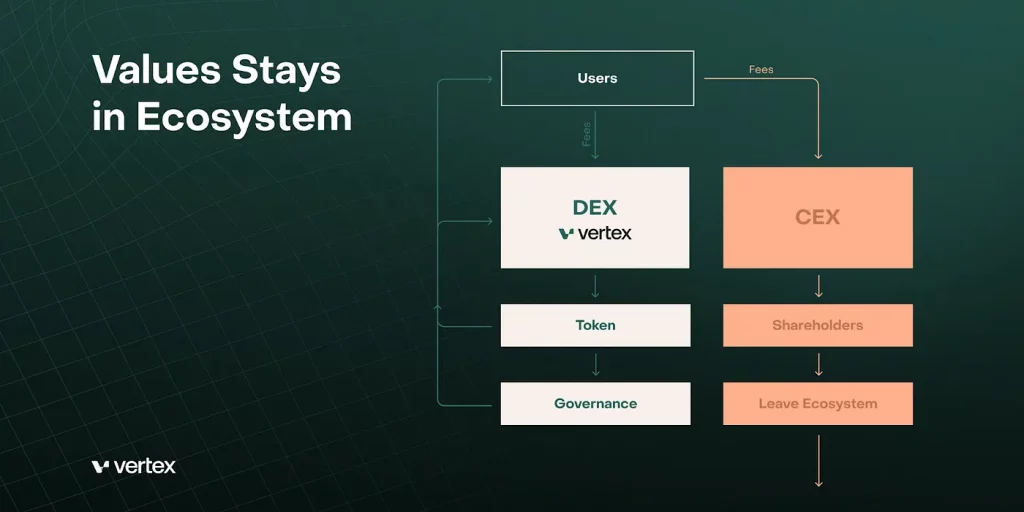
Similarly, Vertex also generates revenue through the interest charged on borrowed funds.
Vertex also takes a cut out of liquidations to grow an Insurance Fund to cover losses in the event of liquidations and defaults.
Revenue Streams
As a DEX, Vertex generates revenue from trading fees. The protocol also earns by capturing a portion of the interested paid out by borrowers on the money market
Fee Breakdown
Vertex offers a fee model designed to cater to various market participants, from price makers and takers to liquidity providers and borrowers.
Here’s a breakdown of the fee structure and its impact on trading on Vertex:
Trading Fee Model:
Vertex’s trading fee model is multifaceted, applying to various aspects of the platform including AMM Liquidity Pools, Borrow/Lend Pools, and the Central-Limit Orderbook (CLOB) operated by the sequencer.
Vertex employs a role-based fee model to cater to different market participants:
- Price Makers: These participants enhance liquidity by placing limit orders, thereby playing a pivotal role in narrowing spreads and reducing slippage.
- Price Takers: These traders execute trades against the liquidity provided by makers and pay a fee for the immediacy of trade execution.
- Liquidity Providers (LPs): They supply liquidity to AMM pools, earning a share of trading fees while also facing risks such as Impermanent Loss.
- Borrowers & Lenders: Participants in Vertex’s money market, either borrowing assets and paying interest or providing liquidity and earning interest.
Incentivization:
- To encourage liquidity provision and compensate for risks like Impermanent Loss, Vertex offers incentives such as competitive maker/taker fee models, fee-based rebates for market makers, and $VRTX token incentives.
Trading Fees:
Vertex has a competitive fee model with respect to industry standards, charging minimal fees for takers and zero fees for makers on major pairs like BTC/USDC and ETH/USDC for both spot and perpetual trades. The trading fee model is designed to foster an efficient trading environment by incentivizing market makers through rebates and token incentives, ensuring liquidity and low trading costs.
Taker Fees: Subject to a minimum fee upon order execution, calculated as minSize × maker.price × feeRate. Additional standard fees apply to any portion of the order exceeding minSize.
Maker Fees: Vertex provides competitive incentives to Makers, including rebates and token rewards, to encourage liquidity provision.
Maker / Taker Trading Fee Model
Fee Denominations & Distribution:
Vertex ensures a clear and transparent fee structure, with all trading fees paid in $USDC. This approach simplifies fee payment and collection, providing consistency across various trading pairs. Initially, all pairs on Vertex are denominated in $USDC, such as BTC/USDC for both spot and perpetuals. The collected fees serve multiple purposes:
- Protocol Revenue: A portion of the trading fees contributes to the protocol’s revenue, ensuring ongoing development and maintenance.
- Insurance Fund: Trading and liquidation fees contribute to Vertex’s insurance fund, safeguarding the platform against unexpected market events and ensuring stability.
- Operational Expenses: Fees are used to cover the essential costs of running the platform, including marketing, development, and other operational expenses.
- $VRTX Liquidity: Part of the fees is allocated to seed the initial liquidity pool for the $VRTX token, enhancing its market stability and availability.
Over time, the revenue generated from trading fees is intended to drive value back to the $VRTX token, aligning with the tokenomics and incentivizing long-term platform growth and user participation.
Sequencer Fees:
Vertex charges a flat sequencer fee for interactions with its sequencer, which matches orders and handles high-speed interactions like deposits, withdrawals, and LP token minting. The fees, denominated in $USDC, aim to balance the cost of gas on the underlying blockchain and ensure a swift trading experience. The sequencer fees are as follows:
- Deposit: 0 $USDC
- Submitting a Liquidation: 1 $USDC
- Withdrawing Collateral: Fees vary based on the asset (e.g., $BTC, $ETH, $USDC).
- Placing an Order that Takes Liquidity: Reduced from 0.1 $USDC to 0 $USDC for specific epochs as part of a promotional incentive.
It’s important to note that Vertex adjusts its fee structure periodically to align with market conditions and the protocol’s operational requirements. All fees are aimed at ensuring the platform’s sustainability, rewarding participants appropriately, and maintaining a competitive and efficient trading environment.
For the most accurate and up-to-date information on Vertex’s fee structure, users are encouraged to refer to the official documentation and announcements.
Funding Rates
Funding rates are integral to the mechanics of perpetual contracts, also known as perpetual swaps. Unlike traditional futures contracts, perpetuals don’t have an expiration date and can theoretically be held indefinitely. However, this unique feature necessitates a mechanism to tether the price of the perpetual contract to the underlying asset’s spot price over time – this is where funding rates come into play.
Function of Funding Rates:
- Price Convergence: In traditional futures markets, the futures price converges with the spot price as the contract approaches expiration. Perpetual contracts, lacking an expiration date, use funding rates to ensure their prices don’t deviate significantly from the underlying spot price.
- Incentive Balancing: Funding rates are used to balance the market by providing incentives for traders. A positive funding rate indicates that the price of the perpetual contract is higher than the spot price, leading long position holders to pay short position holders. Conversely, a negative funding rate suggests the perpetual price is lower than the spot, causing short position holders to pay those holding long positions. This mechanism helps in keeping the perpetual contract price in line with the underlying asset’s spot price.
How Funding Rates Work:
Funding rates are calculated based on the difference between the perpetual contract’s mark price and the underlying asset’s spot index price. Vertex calculates funding rates using the following inputs:
- Spot Index Price: Provided by Stork, a decentralized oracle network.
- Perpetual Contract Mark Price: Determined by the time-weighted average price (TWAP) of the orderbook price.
- Funding Interval: The period over which funding rates are applied. On Vertex, this interval is set to one hour.
The funding index is derived from the difference between the TWAP of the perpetual mark price and the TWAP of the spot index price. The funding payment, a transfer between longs and shorts, is then calculated as a fraction of the funding index, and it’s capped at 10% per day.
Impact of Funding Rates on Trading:
Funding rates influence the profitability and cost of maintaining open positions in perpetual contracts. Traders holding positions in a market with a positive funding rate will pay funding fees if they are long, and receive funding fees if they are short. The opposite is true for markets with a negative funding rate.
Example of Funding Rate Impact on Trading:
Consider a scenario where Alice is trading Ethereum (ETH) perpetual contracts on Vertex. The current spot index price of ETH is $1,000.
- Positive Funding Rate Scenario: If the perpetual contract’s mark price is $1,010 (higher than the spot index price), the funding rate might be positive. Suppose the funding rate is +0.1%. Alice holds a long position of 10 ETH (notional size = $10,100). If she maintains this position over the funding interval, she will pay a funding fee to the short position holders, adding a cost to her trade. For instance, her hourly funding payment might be ($10,100 * 0.1%) / 24 = $0.42.
- Negative Funding Rate Scenario: Conversely, if the perpetual contract’s mark price is $990 (lower than the spot index price), the funding rate might be negative, say -0.1%. If Alice holds the same long position of 10 ETH (notional size = $9,900), short position holders will pay her a funding fee, potentially offsetting some of her trading costs or augmenting her profits. Her hourly funding payment received might be ($9,900 * -0.1%) / 24 = -$0.41.
Key Points to Note:
- Variable Rates: Funding rates are subject to change based on real-time market conditions and the overall market sentiment towards the underlying asset.
- PnL Impact: Funding rates can significantly impact the profit and loss (PnL) of open positions, especially when holding positions over extended periods.
- Active Monitoring: Traders are advised to keep a close watch on funding rates, as they can sometimes represent a substantial part of the trading costs or profits.
Tokenomics
$VRTX is the native token of the Vertex Protocol. It is a fungible ERC20 token that provides utility within the Vertex ecosystem.
The initial supply of $VRTX tokens were strategically launched via a Liquidity Bootstrapping Auction (LBA). This is a mechanism designed to let the community set the token’s price based on market demand and establish its liquidity pool, ensuring market depth from day one.
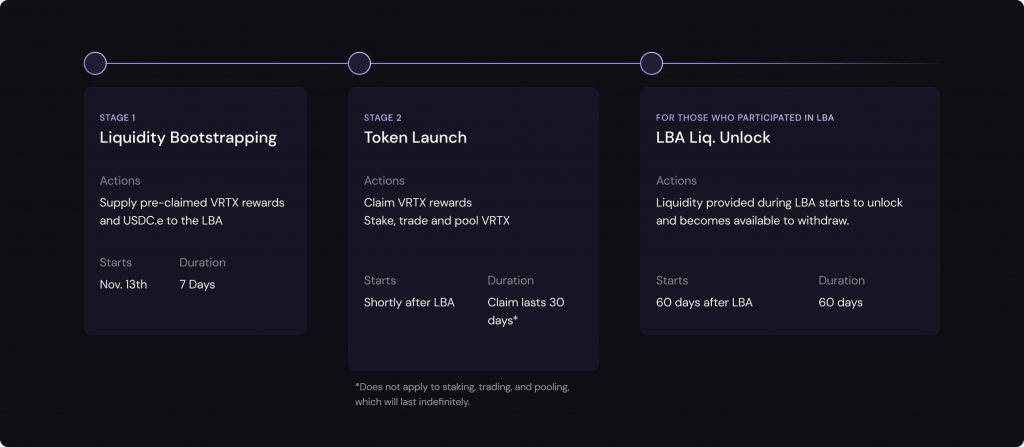
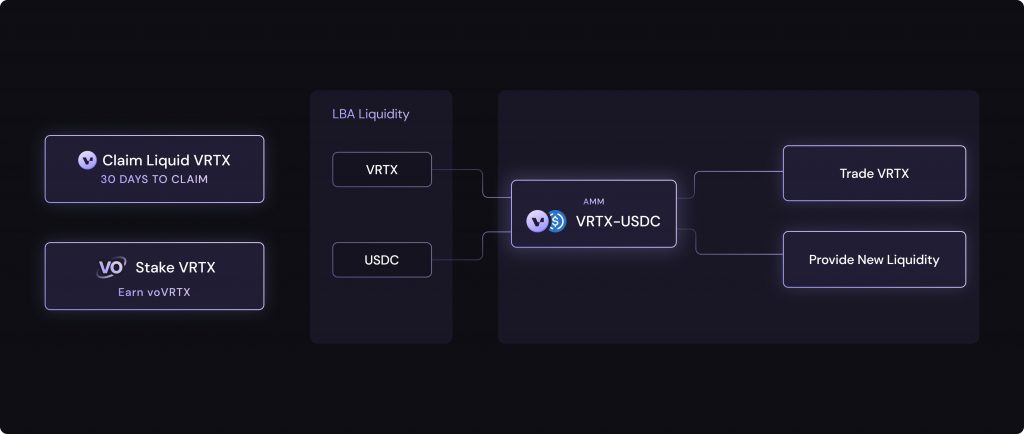
$VRTX is also distributed as trading rewards, incentivizing protocol engagement. Designed with the primary objective of fostering long-term engagement, the $VRTX token is instrumental in promoting the sustained growth and development of the DEX by rewarding users based on their level of commitment and participation.
Utility and Incentive Structure
The core utility of $VRTX revolves around incentivizing activities that contribute positively to the protocol’s longevity. Key utilities include:
- Staking: Users can stake $VRTX tokens to contribute to the security and robustness of the Vertex ecosystem. Staked $VRTX is essential for participating in the protocol’s incentive program, generating a user score called voVRTX.
- Rewards: $VRTX holders are rewarded variably, aligning with their contributions and engagement within the protocol. Activities like trading, marketing, and referrals are recognized and incentivized.
- voVRTX Boost: Staking $VRTX generates voVRTX, a non-transferable score reflecting a user’s commitment. This score amplifies the user’s rewards, fostering long-term participation and greater contribution to the protocol’s success.
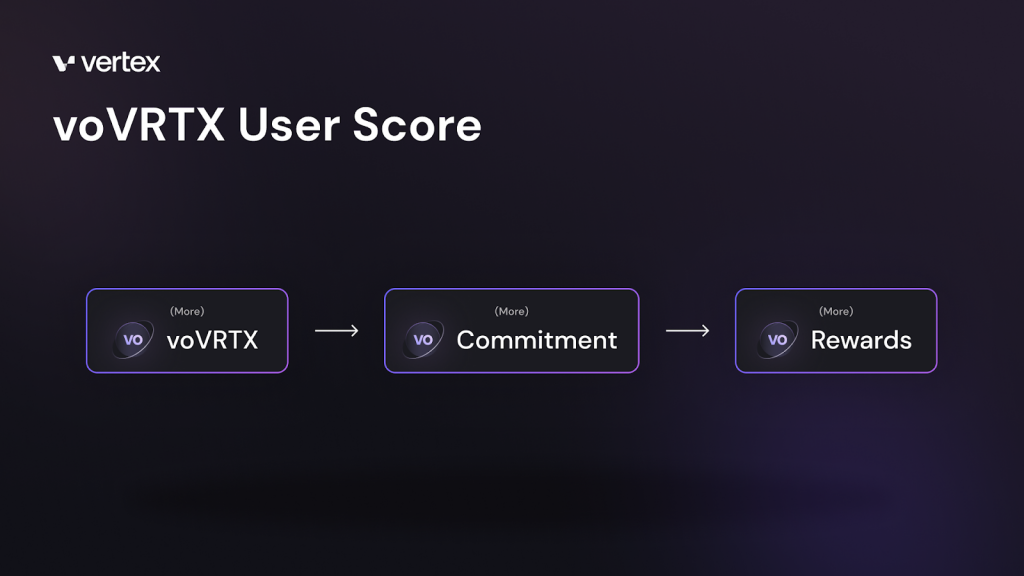
- The boosting mechanism operates on a multiplier effect, with the potential to significantly increase rewards over time. The boost ranges from 1X to 2.5X, based on factors such as the duration of $VRTX staking, level of activity, and length of commitment. This mechanism encourages users to engage deeply with the protocol, offering heightened rewards for their dedication.
Refer to the chart below for a visual explanation of the $VRTX and voVRTX relationship, as well as the incentive structure they support within the Vertex ecosystem.
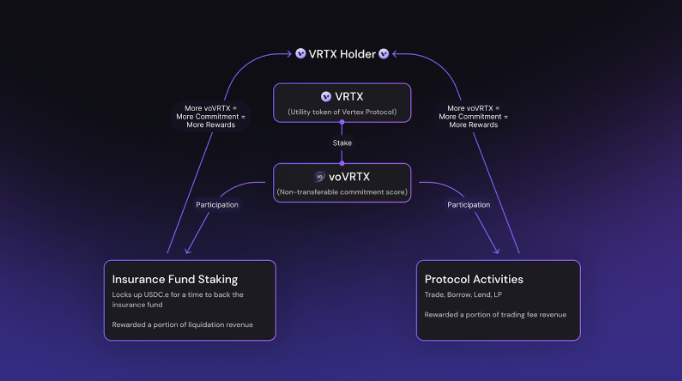
Insurance Fund Staking: Users can stake $USDC.e in the Vertex Insurance Fund to provide additional stability to the Vertex Protocol.
This staking serves a critical function in preventing socialized losses during periods of extreme volatility by covering any potential shortfalls from underwater positions.
The fund acts as a decisive safety net by deploying assets from a segregated pool of $USDC.e to settle margin shortfalls in the event of account bankruptcy.
However, stakers should be aware of the explicit risks:
- Opportunity Cost of Capital: Stakers are committed to a minimum lockup duration of three weeks, during which they cannot utilize their capital elsewhere.
- Staked Capital Risk: In the dire event that the Insurance Fund is depleted, up to 100% of the staked holdings may be liquidated to cover the shortfall before losses are socialized. Despite these risks, stakers are eligible for a share of the protocol’s liquidation revenue, providing a potential yield in compensation for their commitment.
Despite these risks, staking in the Vertex Insurance Fund is incentivized by granting stakers a portion of the protocol’s liquidation revenue, proportional to their contribution to the fund.
It’s important to note that Insurance Fund staking will not be immediately available at $VRTX token launch and is anticipated to be implemented in Q2 2024.
Incentive Mechanisms and Rewards
Vertex introduces various mechanisms to ensure active participants are adequately rewarded:
- Protocol Rewards: Vertex’s primary revenue comes from trading fees, with a portion allocated to the Protocol Treasury. Users demonstrating long-term commitment via voVRTX scores are eligible for rewards from this revenue pool. The voVRTX score also amplifies rewards for Insurance Fund stakers, aligning user incentives with protocol health. In the event of Insurance Fund depletion, staker rewards may increase post-recovery, despite the risks to their staked $USDC.e.
- Trading Fee Revenue: Up to 50% of all trading fee revenue, excluding sequencer fees, collected by Vertex in a single epoch, is allocated to the Protocol Treasury. This portion is then used as rewards and distributed to users based on their sustained participation and dedication to the protocol.
Legal and Regulatory Compliance
It’s crucial to note that $VRTX tokens do not represent any form of shareholding, ownership, or financial interest in Vertex Protocol or its affiliates. The tokens are to be used within the Vertex Protocol and carry no inherent rights other than enabling interaction within the ecosystem. Users are advised to understand and accept the risks involved in holding $VRTX tokens.
Token Distribution
$VRTX’s token distribution strategy is designed to ensure the long-term viability and health of the ecosystem by encouraging sustained participation and contribution from its community.
Total Supply and Distribution Timeline
- Total VRTX Supply: The fixed supply of $VRTX tokens is capped at 1,000,000,000 (1 billion) tokens. The distribution of 90.85% of these tokens is scheduled to occur over a period exceeding 5 years, ensuring a controlled and gradual introduction of tokens into the ecosystem.
- Initial Trading Rewards Program: Launched alongside the Vertex mainnet debut on the Arbitrum platform in April 2023, this program allocated 10.0% of the total $VRTX supply.
Detailed Allocation Breakdown
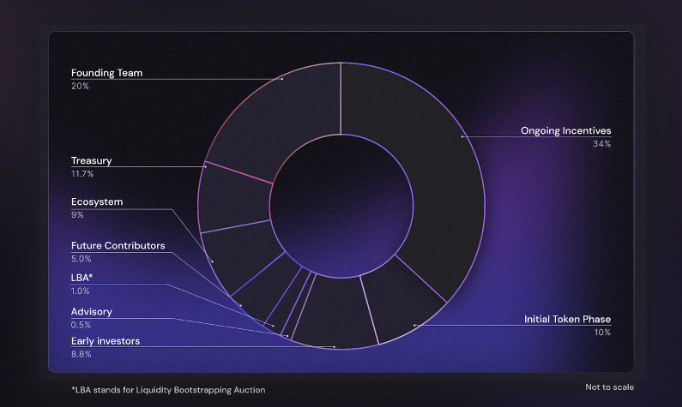
- Ongoing Incentives: 34.0% (340 million $VRTX) of the total supply is allocated to ongoing incentives. This allocation is scheduled to be distributed gradually, tapering over the monthly emissions schedule to encourage long-term participation. To maintain active engagement, unclaimed rewards are designed to revert to the Protocol Treasury after a period of 30 days, ensuring that the incentives continuously circulate within the ecosystem. The duration of this phase extends over 6+ years, reflecting the protocol’s commitment to supporting its community and reinforcing the ecosystem’s health over an extended period.
- Initial Token Phase: 10.0% (100 million $VRTX) was allocated for the initial Vertex Trade & Earn rewards program, which ended with Epoch #7 on November 8th, 2023.
- Early Investors: 8.8% (88 million $VRTX) of the supply is earmarked for early investors, with vesting aligned over 2-3 years from project inception.
- Initial VRTX Liquidity (Vertex LBA): 1.0% (10 million $VRTX) was designated for initial liquidity incentives and has been allocated to the Vertex LBA participants.
- Future Contributors: 5.0% (50 million $VRTX) is reserved for future team growth, potentially entering circulation post vesting, starting from Year 2.
- Ecosystem Development: 9.0% (90 million $VRTX) is allocated for long-term ecosystem growth, with 1% unlocking at Genesis and the remainder vesting linearly over three years.
- Advisory: 0.5% (5 million $VRTX) is set aside for services that help the protocol’s growth, security, and sustainability, beginning vesting in Year 1.
- Protocol Treasury: 11.7% (117 million $VRTX) is allocated to the Protocol Treasury, serving as a strategic reserve for various operational needs, with 5% unlocking at Genesis and the remainder vesting linearly over three years.
- Founding Team: 20.0% (200 million $VRTX) is allotted to the founding team, vesting over a timeline that broadly matches 2-3 years post inception.
Token Emissions
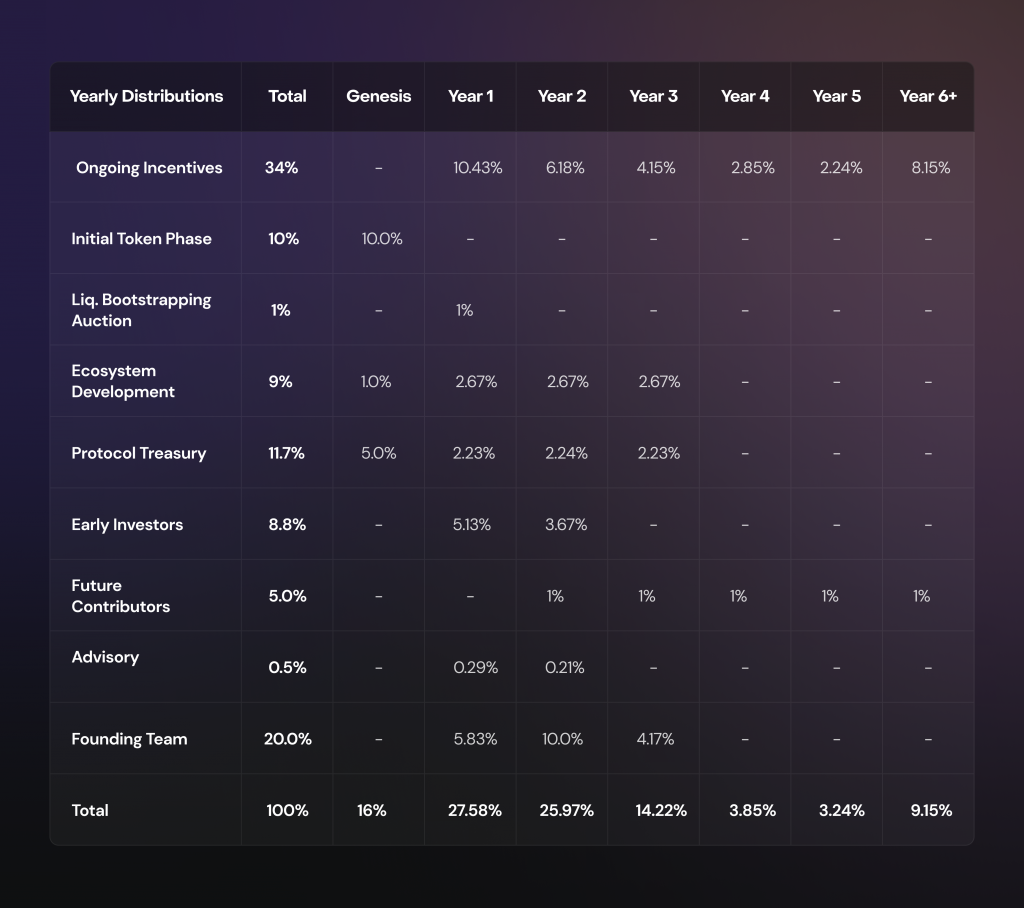
- Higher Initial Emissions: The higher vesting inflation rate in the early years is a strategic decision, commonly employed in tokenomics to rapidly distribute tokens to active users and early adopters, incentivizing platform growth and network security.
- Decreasing Emissions: Over time, the emission rate decreases, aligning with a common practice designed to reduce inflationary pressure and enhance token scarcity, potentially increasing the token’s value as the platform matures and the ecosystem expands.
$VRTX Trading Incentive Rewards
The Vertex Trade & Earn program is designed to incentivize user engagement and trading activity through the distribution of $VRTX tokens. The program aims to align user incentives with the long-term growth of the Vertex protocol by rewarding trading activities.
Rewards are distributed pro-rata, based on the total pool size of $VRTX tokens earmarked for each epoch.
The structure is intended to encourage more trading, thereby increasing market liquidity and user engagement within the platform.
Phases of the Trade & Earn Program
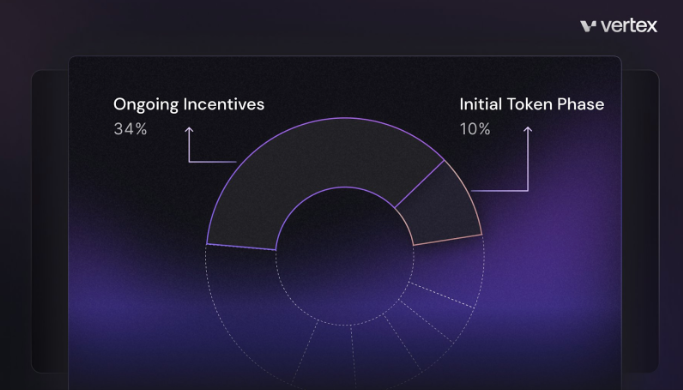
- Initial Token Phase (10.0% / 100 million $VRTX): This phase ran for 7 months, starting from the mainnet launch on Arbitrum in April 2023 until November 8th, 2023. It primarily served as a trading incentive program, aiming to augment market liquidity and engage users in the protocol’s growth.
- Ongoing Incentives Phase (34.0% / 340 million $VRTX): Starting with Epoch #8 on November 8th, 2023, this phase is set to continue for 6+ years. It represents a significant portion of the $VRTX token supply, designed to sustain the protocol’s reward mechanism over an extended period.
Key Parameters and Updates
- Allocation for Trade & Earn Program: Combining the Initial Token Phase and Ongoing Incentives Phase, a total of 44% (440 million $VRTX) of the 1 billion $VRTX tokens are designated for the Trade & Earn program.
- Transition to Ongoing Incentives Phase: As of November 8th, 2023, the program transitioned from the Initial Token Phase to the Ongoing Incentives Phase, marking a shift in the reward distribution strategy.
Reward Distribution Mechanisms
- Epoch Structure: The program is structured in epochs, each lasting 28 days, ensuring a systematic and predictable distribution of rewards. Users can claim their $VRTX rewards 3 days after an epoch concludes.
- Reward Pool Allocation: The Initial Token Phase involved a pool of 100 million $VRTX tokens distributed over 7 epochs. For the Ongoing Incentives Phase, a larger pool of 340 million $VRTX tokens is set for distribution over 72+ epochs.
- Taker and Maker Rewards: The program differentiates between Taker and Maker rewards, each with its own set of parameters and allocation percentages. The distribution is designed to incentivize both market-making and price-taking activities on the platform.
Rewards Claiming Process and Compliance
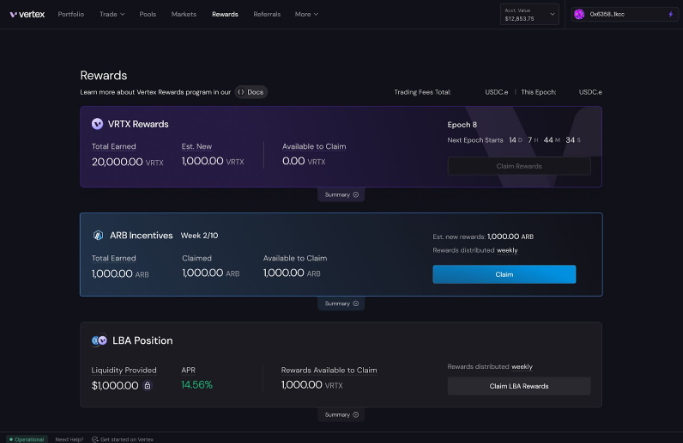
- Claiming Rewards: Users can view and claim their accrued $VRTX and $ARB trading rewards via the Rewards Page on the Vertex app, ensuring a transparent and user-friendly process.
- Compliance and Fair Trading: Vertex upholds a strict policy against wash trading and has mechanisms in place to ensure fair reward distribution, maintaining the trading platform’s integrity and the equitable allocation of rewards.
$VRTX Staking
VRTX Staking on Vertex Protocol offers users the opportunity to participate actively in the ecosystem by staking their $VRTX tokens, thereby earning a share of the protocol’s revenue in USDC. This initiative is designed to reward long-term participation and commitment while aligning the interests of users with the sustainable growth of the protocol.
Staking Mechanism
The Vertex Protocol enables users to stake $VRTX tokens, generating a voVRTX score that reflects their engagement and commitment. This dynamic score increases with the duration of staking, directly influencing reward distribution; longer staking periods result in higher voVRTX scores and potentially greater rewards. Beyond rewards, the voVRTX system promotes protocol stability by encouraging sustained token holdings, mitigating the impact of large-scale withdrawals. Essentially, voVRTX aligns user incentives with the protocol’s long-term health and community engagement, serving as a cornerstone for both security and growth.
Earning Rewards
Staking VRTX allows participants to earn a portion of the protocol’s revenue in $USDC. This incentivizes users to stake their tokens and support the protocol, while also providing them with a passive income stream. Up to 50% of all trading fee revenue, excluding sequencer fees, is allocated to the Protocol Treasury for rewards distribution.
Unstaking Period for $VRTX Tokens
When users unstake their $VRTX tokens, there is a 14-day lock-up period before the tokens become claimable. This period is designed to ensure network stability and security. After the 14 days, users can claim their unstaked $VRTX directly to their wallet from the Vertex app’s Staking tab.
APR and Staking Pool Insights
As of February 13th, 2024, the Vertex Protocol has seen significant engagement, with 53.63% of the liquid supply, amounting to 103M $VRTX, actively staked by the community. This commitment has contributed to a voVRTX pool size of 148M, reflecting the ecosystem’s vibrant participation. The protocol offers an estimated Average Staking Reward of 26.99% APR at the time of writing, although the actual APR may vary based on several factors, including the amount of $VRTX staked, the composition of the $VRTX & voVRTX Pool, and the protocol’s earnings. Users can monitor their estimated and maximum APR, the total staked amount, and their share of the pool directly through the Vertex platform.
Transparency and User Control
The platform provides a detailed breakdown of staking rewards, including total rewards, claimed rewards, and rewards available to claim. Users also have a clear view of their staking history and the ability to manage their staked tokens efficiently.
Integration with Vertex DAO
While the full governance features of Vertex are yet to be rolled out, the intention is for $VRTX staking to play a pivotal role in the future Vertex DAO, empowering users to participate in the decision-making process and influence the protocol’s direction.
Governance
Vertex Protocol, while having its $VRTX token live, does not currently operate under a fully decentralized governance structure. The protocol’s approach to governance is still in development, with plans to integrate a decentralized governance model over time. This approach reflects a cautious and phased strategy, aiming to ensure robust risk management and operational efficiency before transitioning to a community-led governance framework.
Current State of Governance:
- Non-Custodial Nature: Vertex operates as a non-custodial platform, implying that users’ funds are not held by the protocol, minimizing the risk associated with fund access and custody.
- Centralized Sequencer: Presently, the protocol relies on a centralized sequencer for its operations. However, there’s a clear long-term goal to decentralize this aspect of the platform.
- Team’s Role: Trust in the core team, which is fully doxxed and supported by notable VCs and market makers, is crucial at this stage. The team currently oversees key operational and risk management decisions.
Future of Governance:
- Decentralization of Sequencer: Vertex envisions evolving its infrastructure to support a network of decentralized sequencers. This transition aims to distribute operational responsibilities and enhance the protocol’s resilience and trustlessness.
- Phased DAO Integration: The Vertex DAO, a decentralized autonomous organization, is expected to be introduced in stages (e.g., Vertex DAO V1, Vertex DAO V2). This gradual rollout is designed to manage complexities and risks associated with transitioning to community-driven governance.
- Fee Distribution and DAO Governance: Eventually, key decisions like fee distribution are intended to fall under the purview of Vertex DAO governance. This move will align the protocol’s economic incentives with its users and stakeholders.
- Awaited Governance Details: Detailed plans regarding the structure, functions, and participation mechanisms of Vertex DAO are anticipated to be released in due course. These details will provide clarity on how the community can engage with and influence the protocol’s direction.
However, for now, token-based decentralized governance in the form of $VRTX is not live yet.
Risks
- Smart contract risk: Users should be aware that audits don’t guarantee that a protocol is 100% secure. The smart contracts might contain unknown vulnerabilities that are exploited by malicious actors.
- Perpetual Contracts (Perps) Risks: Perps differ from traditional futures contracts as they lack a pre-specified delivery date and can be held indefinitely. Users trading Perps generally use leverage, which can amplify both gains and losses. If the market moves against a user’s position, they may incur a total loss greater than their initial investment.
- Margin Requirements: Users trading on margin must carefully consider their investment objectives, level of experience, and risk tolerance. They should also be prepared to meet margin requirements that may change over time. Failure to meet these requirements may result in the closure of positions and potential losses.
- Execution Risks: While Vertex’s trading platform is automated, market prices can change between order placement and execution, leading to differences between the requested and executed prices. There are also risks associated with online trading systems, including software and hardware failures and internet disconnection.
- Regulatory Risks: Vertex Protocol is not authorized or regulated by financial authorities like the Financial Conduct Authority (FCA) or any other regulatory body. This means that users of the platform do not benefit from the protections available to clients receiving regulated investment services, such as access to compensation funds and dispute resolution services.
- Economic Risk: Analyzing the risk profile of assets in liquidity pools, including liquidity depth, asset liquidity, and counterparty risk, is essential. This is important to ensure that liquidators have an incentive to step in and prevent the platform from accruing bad debt.
- Oracle risks: There are risks associated with oracles, including whether they are off-chain or on-chain, and potential manipulation of prices are considered. The liquidity profile of assets in the oracle process is assessed.
Security
Audits
Vertex’s open-source contracts are publicly accessible on GitHub, inviting community scrutiny and collaboration.
Vertex underwent a comprehensive code audit of its contracts conducted by OtterSec, an auditing team known for its extensive experience and reputable track record in both Web3 and traditional security sectors.
OtterSec’s portfolio of audited projects includes prominent names like Jito, Kamino, Drift, Tensor, and the interoperability protocol LayerZero, with their audits safeguarding over $960M in assets and identifying core issues in 66% of the 120+ projects audited.
Bug Bounties
In collaboration with Hacken, Vertex has established a Bug Bounty program, actively encouraging the community and security researchers to identify and report potential vulnerabilities. This initiative is hosted on Hacken’s platform, reflecting Vertex’s proactive stance in fortifying its protocol against security threats. The bounty program offers significant rewards across various tiers:
- Critical: $50,000 – $500,000
- High: $5,000 – $50,000
- Medium: $2,000 – $5,000
- Low: $50 – $1,000
Participants are urged to thoroughly understand the bounty program’s scope and rules, available in detail on the Hacken platform, and to adhere to proper disclosure guidelines when reporting potential issues.
Team
The founders of Vertex Protocol are doxxed and the team is led by experienced professionals from various sectors. Key members include:
- Darius Tabatabai – Co-Founder: Brings a wealth of trading experience from notable firms like CrossTower, JST, Credit Suisse, and Bank of America Merrill Lynch, specializing in options, commodities, and FX.
- Alwin Peng – Co-Founder: Known for being the youngest-ever employee at Jump and establishing RandomEarth, an NFT marketplace on Terra.
- SJ Park – Head of Strategy: Possesses a decade of trading expertise in Rates and Credit and has served as a Portfolio Manager at Goldman Sachs.
- Jeff Blockinger – General Counsel: Offers extensive legal expertise across multiple fields, previously holding roles such as Chief Legal Officer at Och-Ziff during their IPO and CEO at Association for Digital Asset Markets.
- Frank Jia – Head of Engineering: Extensive full stack development expertise, previously holding roles at SAP and Shopify.
Project Investors
Seed Funding and Initial Vision on Terra
Initially, Vertex secured $8.5 million in seed funding with the ambition to develop on the Terra ecosystem. The plan was to create a platform enabling trading across various currencies and to provide a multi-currency version of Terra’s Anchor protocol.
This vision aimed to extend DeFi liquidity beyond just U.S. dollar-pegged stablecoins on the Terra ecosystem and foster the adoption of forex trading.
Strategic Pivot from Terra to Arbitrum
The collapse of the Terra ecosystem in May 2021 marked a critical turning point for Vertex. The team, leveraging its strong background in trading and risk management, protected its treasury during the Terra collapse and promptly shifted its strategic focus.
Recognizing the need for a platform that could deliver optimal performance and meet the growing demand for non-custodial trading solutions, Vertex pivoted to Arbitrum. This shift signified a transition from the original decentralized forex model to a more comprehensive perpetual trading protocol.
Evolution into a Perpetual Protocol on Arbitrum
On Arbitrum, Vertex evolved its offering to align with the market’s needs, focusing on a perpetual protocol that combines the efficiency and features of centralized exchanges with the transparency and security of DeFi. The pivot to Arbitrum was strategic, leveraging the platform’s L2 capabilities for optimal performance and aligning with the market’s needs.
Investment from Wintermute Ventures
In a significant development post-pivot, Vertex Protocol received an undisclosed strategic investment from Wintermute Ventures in June 2023. This partnership has been instrumental in enhancing Vertex’s trading capabilities and liquidity, underlining the confidence of industry leaders in Vertex’s market potential and strategic direction.
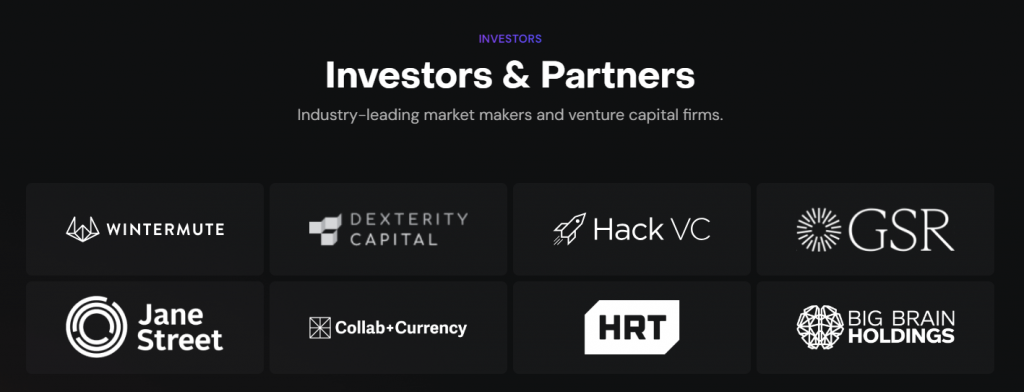
Additional Information
Glossary
- Account Value / Equity: The total dollar value of an account, calculated as Assets minus Borrows plus or minus Unsettled USDC. This value represents the net worth of the account in the Vertex ecosystem.
- Assets: Any holdings within an account that have a positive balance. Assets automatically earn interest, enhancing the account’s value over time.
- Borrows: Holdings within an account that have a negative balance, indicating borrowed funds. Interest is paid on these borrows, which must be managed to avoid financial strain on the account.
- Unsettled USDC: Represents the portion of open perpetual profit and loss (PnL) that has not yet been settled. Settlements occur periodically, and once a position is closed, contributing to the account’s equity.
- Available (Spot Trading): The balance of an asset that can be sold without incurring borrowing. This figure is adjusted for open orders and assets allocated as collateral, reflecting the immediate liquidity available for trading.
- Max Available (Spot Trading): The total quantity of an asset available for trading, factoring in margin borrowing. This figure enables traders to leverage their positions by automatically borrowing against their collateral during trade execution.
- Available (Depositing): The current amount of funds a user can deposit from their wallet into Vertex, reflecting the user’s liquidity outside the platform.
- Available (Withdrawing): The balance of an asset that can be withdrawn without exceeding margin requirements or borrowing, accounting for open positions and collateral usage.
- Deposit APR: The annualized interest rate paid on deposits, encouraging users to add funds to the Vertex ecosystem.
- Borrow APR: The annualized interest rate charged on borrowed funds, influencing borrowing decisions and financial planning within the platform.
- Net APR (Balances): The average interest rate effectively paid or charged on an account’s balances, summarizing the financial impact of both deposit and borrow activities.
- Maintenance Margin (Funds Until Liquidation): Represents the threshold below which an account becomes eligible for liquidation, determined by the maintenance margin requirements of assets, borrows, and perpetual positions.
- Available Funds (Initial Margin): The amount of funds available for initiating new trades or positions, governed by the initial margin requirements of the account’s holdings.
- Maintenance Mode: A state where an account has depleted its available funds for taking on new risk, necessitating de-risking actions to avoid liquidation.
- Account Leverage: A measure of the extent to which an account’s trades are leveraged, indicating the ratio of used margin to the value of the account’s assets.
- Trade Leverage (Perpetuals): The leverage applied on a per-trade basis, determining the maximum position size relative to available funds. This feature aids in trade sizing and risk management.
- Margin Usage: The percentage of an account’s margin that is utilized by open positions and the maintenance margin requirements, influencing liquidation risk.
- Perp PnL: The cumulative profit or loss across all open perpetual positions, reflecting both settled and unsettled amounts and impacting account equity.
- Est. Perp Position PnL: An estimate of the total profit or loss for a specific perpetual position, calculated based on the average entry price and the current Oracle Price.
- Est. Liquidation Price: The price level at which a position becomes eligible for liquidation, used for risk assessment and management.
- Position Margin: The maintenance margin requirement for an individual perpetual position, part of the account’s overall margin requirements.
- Liquidation: The process of closing positions or assets when an account’s maintenance margin reaches zero, executed to protect the financial stability of the platform.
- Oracle Price: The benchmark price for perpetual contracts, derived from external exchanges and used for calculating PnL and liquidation thresholds.
- Index Price: The benchmark price of the underlying asset in a perpetual contract, crucial for determining funding rates.
- Last Price: The most recent trading price for an asset on Vertex, visible in the market overview.
- Mid-Book Price: The average price between the highest bid and the lowest ask in the Vertex orderbook, reflecting immediate market depth.
- Open Interest: The total value of outstanding perpetual contracts for a specific market, denoted in USDC, indicating the market’s liquidity and activity level.
- Predicted Funding Rates (1h/annualized): The forecasted hourly and annualized funding rates for a perpetual contract, based on the Index Price and trade activity on Vertex.
- Maker Fee / Taker Fee: Fees applied to trades based on their impact on the order book liquidity; Maker fees for adding liquidity and Taker fees for removing liquidity.
- Avg. APR (LP Position): The average annual percentage rate for liquidity provider positions, reflecting the combined return from trading fees and interest on deposits.
- LP Position Composition: The specific assets comprising a liquidity provider’s position, relevant for understanding exposure and returns.
- Pool APR: The estimated annual percentage rate for liquidity pools, incorporating trading fees and deposit interest, indicative of the earning potential for liquidity providers.
- LP Position PnL: The profit or loss on a liquidity provider position, accounting for the current value versus the entry value, including fees and interest.
- Impermanent Loss: A potential loss for liquidity providers when the relative prices of assets in a pool change, affecting the value of their position compared to holding assets outside the pool.
Partnerships
Vertex has formed strategic partnerships with leading firms in the digital asset and blockchain security sectors, enhancing its offerings, security, and market liquidity. These collaborations reflect Vertex’s commitment to providing a secure, efficient, and user-friendly trading environment for its users.
OtterSec Security Partnership
Vertex established a Security Partnership with OtterSec, a renowned blockchain security firm, to conduct a comprehensive audit of the Vertex protocol. This partnership aims to ensure the highest security standards for Vertex’s decentralized exchange, reflecting Vertex’s commitment to protecting its users and their assets through rigorous security measures.
Collab+Currency: Strategic Investment and Partnership
Vertex has partnered with Collab+Currency, a seasoned crypto-focused venture fund, to its Partner Network. This partnership, established through Collab+Currency’s participation in Vertex’s seed round, brings valuable expertise in DeFi, crypto, and consumer products to the Vertex ecosystem. It underscores the collaborative effort to shape the future of crypto and enhance Vertex Protocol’s offerings and market presence.
Wintermute Ventures Investment
Vertex received a strategic investment from Wintermute Ventures, enhancing liquidity and deepening business ties. This partnership underscores Wintermute’s confidence in Vertex Protocol’s potential to meet the market demand for noncustodial trading solutions, combining the efficiency of centralized exchanges with the security and transparency of DeFi.
Toa Capital Partners for Enhanced Liquidity
Toa Capital Partners, a proprietary algorithmic trading firm, partnered with Vertex to provide deeper on-exchange liquidity. This collaboration brings Toa Capital’s traditional finance expertise and innovative trading solutions to Vertex, promising to improve the trading experience for users of all sizes through better liquidity and tighter spreads.
Selini Capital for Market Liquidity
A strategic partnership with Selini Capital, a notable quantitative trading firm and liquidity provider, aims to enhance market liquidity on Vertex Protocol. Selini Capital’s expertise in quantitative trading and technology contributes to Vertex’s vision of delivering an exceptional trading experience by providing improved liquidity, tighter spreads, and a robust trading environment.
Haruko Partnership for Risk Management
Vertex Protocol announced a partnership with Haruko, a top provider of digital asset infrastructure solutions, to offer advanced risk and portfolio management for institutional digital asset traders. This collaboration allows mutual clients to access real-time trading activity and portfolio exposure on Vertex Protocol, offering a comprehensive view across their entire portfolio for optimized risk assessment and management.
Integrations
Vertex Protocol has strategically integrated with several platforms and services to enhance its ecosystem, offering users an improved trading experience, enhanced security, and innovative trading options. These integrations play a crucial role in Vertex’s mission to provide a comprehensive and user-friendly DeFi platform.
Axelar: Facilitating Cross-Chain Deposits
Vertex Protocol has partnered with Axelar, integrating Squid Router for seamless cross-chain deposits. This collaboration enables traders to bridge and deposit assets from 8 different chains directly into Vertex accounts, revolutionizing the deposit process with an average completion time of 2 minutes. Axelar’s secure cross-chain messaging protocol, securing over $7 billion in transactions, simplifies the bridging and swapping process, eliminating the need for multiple steps across different platforms. This integration marks a significant step towards simplifying the trading experience on Vertex, offering users quick, secure, and direct cross-chain transactions without leaving the Vertex app.
Elixir: Revolutionizing Orderbook Liquidity
Vertex has integrated with Elixir, a decentralized protocol that democratizes market-making on its platform. This partnership allows anyone to become a market maker on Vertex through Fusion Pools, deploying the collective capital of retail users in a delta-neutral model to provide algorithmic liquidity on central-limit orderbooks. This collaboration not only enhances liquidity and tightens the bid-ask spreads but also aligns incentives and introduces complete transparency in liquidity provision.
STFX: Social Trading and Automated Investment Opportunities
STFX, a DeFi & SocialFi protocol, has integrated Vertex to bring deeper liquidity and faster trade execution to social trading. This integration enables STFX users to access various new perpetual markets, improving trade execution and reducing trading fees. By leveraging Vertex’s SDK, STFX enhances the user experience with more efficient, immersive, and rewarding trading on its platform.
Chainlink Data Streams: High-Frequency Market Data
Vertex Protocol has announced its integration with Chainlink Data Streams to access high-frequency market data on Arbitrum. This integration ensures that Vertex users can access secure and reliable market data with sub-second resolution, providing a high-performance user experience without compromising on decentralization and transparency. Chainlink’s robust oracle infrastructure enhances the platform’s security and enables a CEX-like trading experience.
Notifi: Push Notifications for Traders
Vertex has partnered with Notifi to bring push notifications to traders, enhancing communication and user engagement. This integration allows users to receive alerts around trades, account health, and more directly to their preferred social accounts, such as Discord, Telegram, and email. It simplifies the process of staying informed about important trading events and announcements.
Pear Protocol: Optimizing Cross-Margin Trading
Vertex Protocol has integrated with Pear Protocol to enhance its cross-margin trading capabilities. This collaboration introduces an advanced risk management framework, allowing users to leverage shared $USDC as margin across various positions. Pear Protocol’s integration improves liquidity, accelerates trade execution, and simplifies portfolio health calculations, elevating the trading experience on Vertex’s platform.
Perpy Finance: Social Copy Trading
Vertex has partnered with Perpy Finance to introduce social copy trading to its platform. This collaboration enables talented traders to create trading vaults for on-chain perpetual products, allowing followers to deposit funds and mirror the performance of their chosen traders. Perpy’s integration with Vertex offers users a new revenue stream and access to the market performance of popular traders, enhancing the social trading experience.
FAQ
Is Vertex Protocol a non-custodial trading platform?
Yes, Vertex Protocol is a non-custodial trading platform. It allows traders to deposit collateral into audited smart contracts, enabling leverage within the system. Being non-custodial means users have complete control over their assets and can withdraw their available funds at any point without any intermediary.
What is cross-margin trading and how does it benefit users?
Cross-margin trading allows traders to use multiple forms of collateral, sharing margin across positions. This system considers the assets (deposits, positive PnL, pools, and spreads) and liabilities (perp positions, negative PnL, and borrows) of users, enabling them to maximize their assets and offset liabilities efficiently.
Can users set TP/SL (Take Profit/Stop Loss) orders on my positions?
Yes, traders can set TP/SL orders for open perpetual positions to manage risk and secure profits efficiently.
How does Vertex Protocol integrate money markets into its system?
Vertex Protocol integrates money markets to enable leveraged spot trading and borrowing. This integration ensures that users’ deposits are automatically part of the underlying money market, allowing users to earn interest and maintain margin requirements effectively.
How does One-Click Trading (1CT) enhance the trading experience on Vertex?
One-Click Trading (1CT) streamlines the trading process on Vertex by allowing users to sign one approval transaction at the start of a session, enabling subsequent actions within the app without the need for further approvals.
This feature not only accelerates trade execution but also simplifies the user experience, making it similar to that of centralized exchanges while retaining self-custody benefits.
What strategies can users employ to manage the impact of volatility on their collateral in cross-margin trading?
In cross-margin trading, the impact of volatility on collateral can be significant. It’s important for traders to diversify their collateral types and monitor the initial and maintenance weights assigned to each. This helps in maintaining a balanced portfolio and mitigating the risk of margin calls or liquidations due to market fluctuations.
How do fees work in Vertex Protocol?
Maker fees are 0% for all markets. They are applied to orders that add liquidity to the orderbook, such as limit orders that don’t immediately cross the book.
Taker fees range between 0.02 – 0.04%, depending on the market. These fees apply to orders that do immediately cross the book, like market orders.
- Spot fees are 0 bp for stables and 0 bp / 3 bps for core markets ($BTC & $ETH).
- Futures fees are 0 bp / 1 bps for stables and 0 bp / 2 bps for core markets.
- Alternative markets (non-BTC & non-ETH) have a fee of 0 bp / 4 bps for spot and 0 bp / 3 bps for futures.
What are the minimum deposit and order size requirements?
Vertex Protocol doesn’t impose a minimum deposit amount or minimum $ value per trade. However, there is a minimum order size per market, denoted in the asset (e.g., ‘$ETH’ or ‘ETH-PERP’). For example, for the ARB-USDC Perpetual (ARB-PERP), the minimum order size is 800 $ARB. Trades below the minimum order size are invalid. Users can find the minimum order size for each market under ‘Market Details’ or in the product specification documents.
How are collateral and available funds calculated?
Funds Available represent the value of the collateral, weighted by the initial margin weights of the deposited asset. This cross-margin trading protocol allows the utilization of different types of collateral as margin, with a discounted weight applied to more volatile types to determine their impact on Funds Available. Note that USDC is valued 1:1 with face value.
What does a negative balance mean and how can users settle it?
A negative balance indicates that a trader is borrowing that asset, typically due to perp positions with negative PnL and non-USDC assets as collateral.
To settle a borrowed balance, traders can deposit the amount they are borrowing or convert another balance (e.g., sell $wETH for $USDC). The ‘Repay’ button in the balances table or the navbar helps users manage this process.
What is the ‘Repay’ feature and its significance?
The ‘Repay’ feature in Vertex Protocol is essential for managing borrowed balances, especially in scenarios where a trader has a negative balance due to borrowing for settlement of negative PnL positions.
This feature allows traders to either deposit the borrowed amount or convert other balances to settle the debt, ensuring their portfolio remains healthy and their risk of liquidation is minimized.
How should users interpret and act upon the ‘Liq. Risk’ metric in their account?
The Liquidation Risk metric indicates the proximity of an account to the liquidation threshold.
A Liquidation Risk nearing 100% suggests that positions are at high risk of being liquidated.
It’s advisable for traders to take preventive measures such as reducing position sizes, adding more collateral, or closing out positions to mitigate this risk.
What are Margin Usage and Funds Available?
Margin Usage is the percentage of the initial margin used by open positions. If it reaches 100%, no new positions can be opened. Funds Available represent the initial weighted margin unused. If it reaches $0, no new positions can be opened. Also known as Free Collateral or Available Margin.
How does the weighting system work for collateral?
In cross-margin systems accepting multiple forms of collateral, weights discount more volatile collaterals. The initial weight determines the amount of collateral an account has to initiate positions, while the maintenance weight determines the margin to maintain positions to avoid liquidation. These weights help traders understand their account’s health in terms of trading ability and proximity to liquidation.
What should users know about the migration from USDC.e to native USDC on Vertex?
The migration from $USDC.e to native $USDC was scheduled to start on Jan 11th, 2023 and has been executed to enhance the platform’s integration within the Arbitrum ecosystem. During this migration, withdrawals were initially processed in USDC.e, transitioning to native $USDC once $USDC.e was depleted from Vertex’s contracts. This change aimed to streamline the onboarding process and improve overall compatibility. The migration was designed to be seamless, requiring no manual actions from users, as it was fully automated.
How do liquidations work in Vertex?
Liquidation occurs when the Oracle Price causes an account to fall under maintenance margin requirements.
The riskiest positions/balances are liquidated first until the account is no longer eligible for liquidation.
Traders should keep an eye on their ‘Funds Until Liq.’ and ‘Liq. Risk’ metrics to manage their risk. The displayed Liq. Price is an estimate based on the account’s current state and position health.
Does Vertex plan to expand to other blockchains?
Yes, Vertex has plans to integrate with additional blockchains in the future. The protocol currently operates on Arbitrum and has integrated cross-chain deposit functionality from various blockchains to enhance accessibility and user convenience.
Where can I find the audit report for Vertex?
The full audit report for Vertex Protocol, conducted by OtterSec, is publicly available. Read the report here.
Where can I access Vertex’s open-source contracts?
Vertex’s open-source contracts are available on their GitHub repository, which can be accessed here. This transparency allows for community scrutiny and contributions, further enhancing the protocol’s security and reliability.
What are the benefits of staking $VRTX in the Vertex Protocol?
Staking $VRTX in the Vertex Protocol enables token holders to earn a portion of the protocol’s revenue in $USDC.
What is the unstaking period for $VRTX tokens, and how does it work?
When users unstake their $VRTX tokens, there is a 14-day lock-up period before the tokens become claimable. This period is designed to ensure network stability and security. After the 14 days, users can claim their unstaked $VRTX directly to their wallet from the Vertex app’s Staking tab.
How do referrals work on Vertex, and what are the benefits?
The referral program on Vertex rewards both the referrer and the referral. When a referral makes a fee-paying trade, they receive a 10% boost to their $VRTX rewards, while the referrer earns 10% of the trading rewards generated by the referral during the epoch. This system incentivizes users to onboard new traders to the platform, mutually benefiting from increased trading activity.
Which countries’ users are restricted from using Vertex?
Vertex Protocol complies with legal and regulatory standards, resulting in restricted access from specific territories. Notably, users from the United States of America and other countries including Belarus, Cuba, Iran, North Korea, Russia, Syria, and the Ukraine regions of Crimea, Donetsk, and Luhansk are not permitted to access the services offered by Vertex Protocol, in accordance with the platform’s Terms of Use.


